Garmin has just announced the new Edge 850, alongside its sibling, the Edge 550. The two units are nearly identical at first glance, but as always, Garmin differentiates them slightly in both hardware and software features. But that wasn’t the only things Garmin released today, they also announced the new Garmin Rally X10 power meters, which covers the Garmin Rally 110 & 220 editions for both road Look KEO and Shimano SPD-SL, and Shimano SPD (off-road typically).
In any event, for the Edge 850, the unit essentially takes the existing Edge 1050, and shrinks it down. In fact, one might even argue the Edge 850 is better suited for crappier climates with lots of rain, since it has the full set of buttons on all sides, which the Edge 1050 lacks. But beyond that, the Edge 850 gets all of the new hardware and software features, including the bike bell, spoken voice prompts, a new more brilliant display, Garmin Pay, and more. But, that comes at not just an increased price, but also a drastically reduced battery life.
I’ve been testing the Edge 550 & Edge 850 over the past while, across all sorts of conditions and terrain. From dry days to wet days, on-road to off-road, mountains to flats, you name it. All to figure out what works well, and what falls a bit short. As usual, none of my reviews are sponsored. So, let’s dive into it.
What’s New:
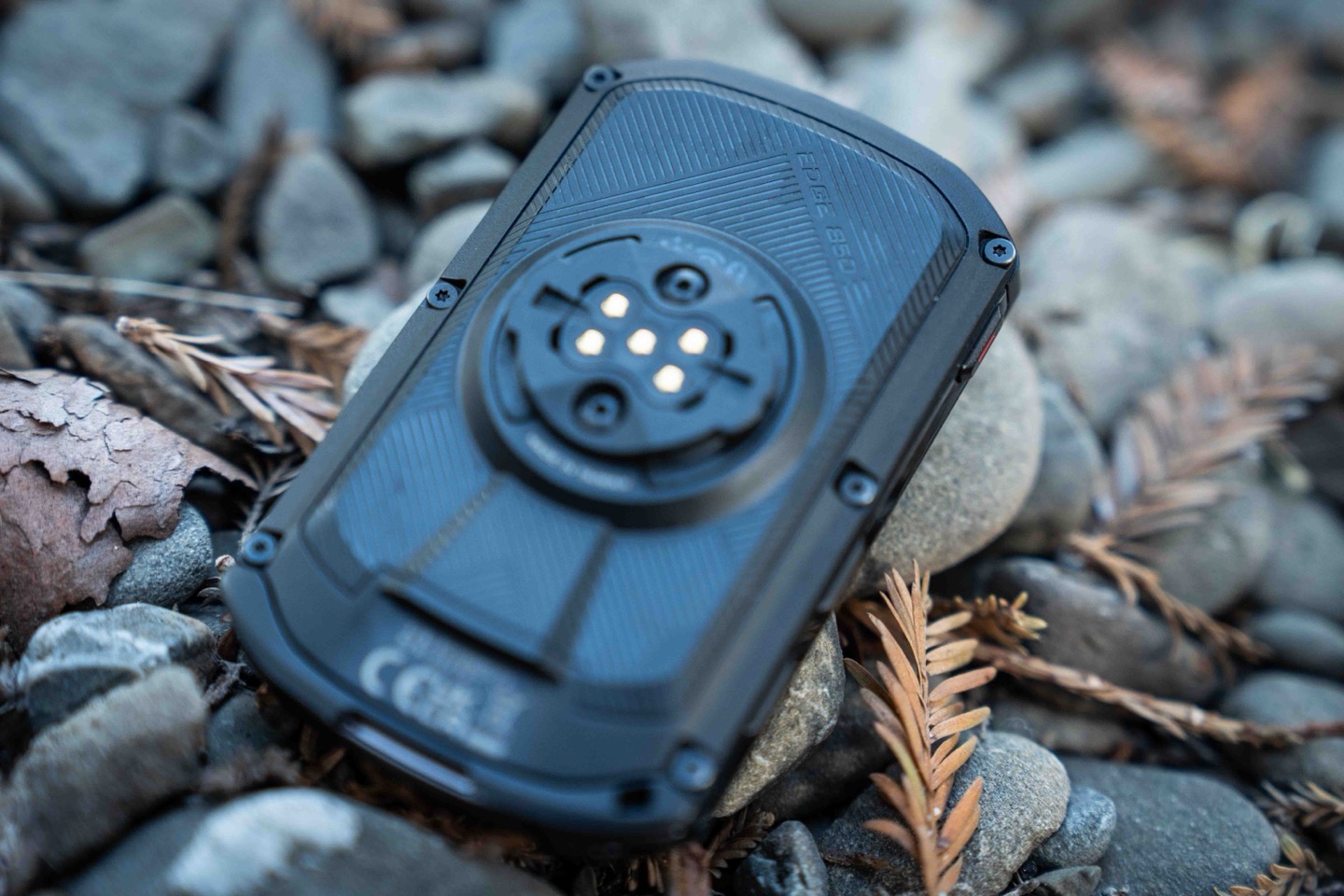
The Edge 850 is essentially an Edge 1050 in a smaller form factor. It’s frankly as simple as that. But, there are still new software things compared to the Edge 1050 (fear not, an imminent firmware update will give the 1050 those added software features). And of course, if you’re coming from the Edge 840, you’ll want to know what’s new compared to that. So, let’s get into it:
– Added speaker (previously just a beeper)
– Added Bike Bell (using new speaker)
– Added voice turn spoken prompts (using new speaker)
– Added Garmin Pay
– Increased display size from 2.6” to 2.7”
– Changed display type from transflective to transmissive LCD
– Added 5Hz GPS/GNSS sampling/recording capability (5x/second)
– Improved processor speed (same as Edge 1050 now)
– Increased storage from 32GB to 64GB
– Extended Garmin Cycle Coach to account for goal course demands (e.g., more elevation, progress towards that goal, etc…)
– Added ’Smart Fueling’ based on user profile, weather, course
– Updated Power Guidance to account for event altitude and user acclimation
– Added WorldWide TrailForks data as standard to all units (only
– Added Gear Ratio Analysis post-ride (electronic groupsets)
– Improved map rendering engine for faster performance
– Added GroupRide features, including GroupRide data Averages (You vs Group average for last 5 mins for HR/Power/Cad/Speed/Watts/Kg)
– Updated Weather Widget with more detailed forecast
– Added weather layers in map view
– Battery life specs drop to 12 hours, or 36 hours in battery saver mode
Plus, all these things they introduced on the Edge MTB a few months back (Edge 1050 already got):
– Added 5Hz (5 times a second) data recording mode while descending
– Added Timing Gates feature to automatically take splits on route
– Added new Downhill MTB profile
– Added new Enduro profile
– Added new eEnduro profile
– Added automatic run/tracking for downhill MTB
– Added new Climb/Descent lap tracking in Enduro profile (with manual lap button)
– Added enhanced Forksight feature (shows more data on upcoming trails at forks)
– Added post-ride trail breakdown
– Removed default ’Smart Recording’ option (woot!!!!)
Now, when it comes to the differences compared to the Edge 550 that was also just released, it’s the following:
– Edge 850 has an actual speaker (Edge 550 has a beeper)
– Edge 850 has the bike bell (Edge 550 doesn’t)
– Edge 850 has voice prompts (Edge 550 doesn’t)
– Edge 850 has a touchscreen (Edge 550 doesn’t, purely button-based)
– Edge 850 has Garmin Pay (Edge 550 doesn’t)
– Edge 850 has 64GB of storage, versus 32GB on the Edge 550
– Edge 850 has preloaded maps for two regions, Edge 550 for one region (free downloadable global maps are available for all other regions, at full fidelity)
– Edge 850 has on-device address search (e.g., 131 Maple street), Edge 550 doesn’t
– Edge 850 has on-device round-trip route creation, Edge 550 doesn’t
Of random notables, here’s how the two units are nearly the same in the hardware department:
– Both units have 2.7” transmissive LCD screens with 1,000 nits
– Both units have resolutions of 420×600 (they are identical screens)
– Both units have the exact same case size (54.6 mm x 92.2mm x 16.8mm)
– Both units are IPX-7 water resistant (30 minutes at 1-meter deep)
– Both units have same 7-button layout (regardless of screen)
– Both units have full topographic maps for the region you bought it in, preloaded
– Both units now have preloaded Trailforks (previously just 840)
Got all that? Fear not, my Edge 550 review is coming shortly, just need to finish editing the video and photo sorting, so expect that in the next day or so. Realistically, though, it’s virtually identical to the Edge 550 in all my testing, save simply not having the bike bell/speaker/touchscreen (and being $100 cheaper).
The Basics & Configuration:
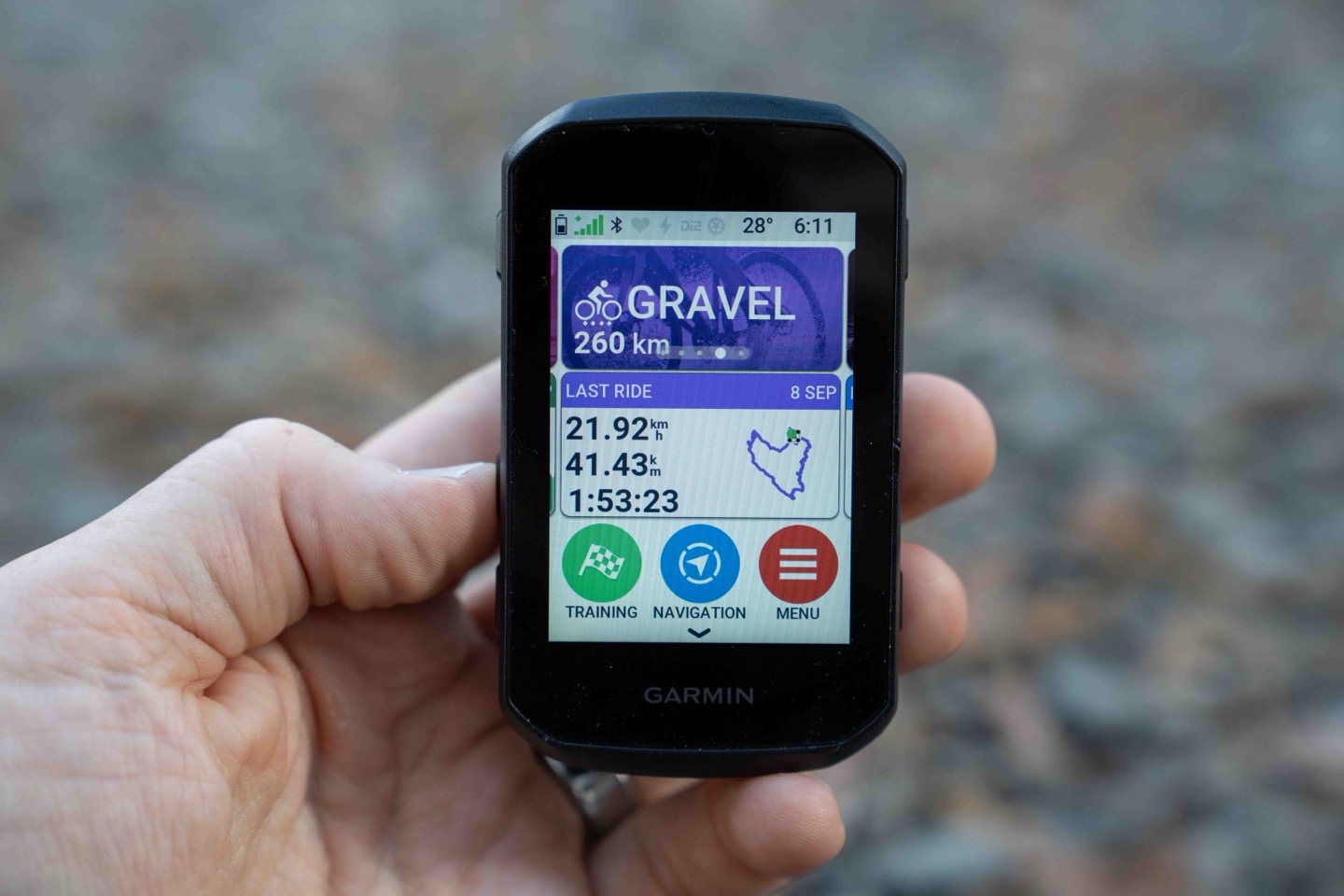
Starting off with the basics, the Edge 850 features both a touchscreen and buttons. This means you can access things via either touch or buttons. So if the weather is non-cooperative (either rain or cold), it’s not a problem. You’ve got three buttons on the left side, two on the right, and two on the bottom facing you. The two bottom ones are for starting/stopping (right), and lap (left).
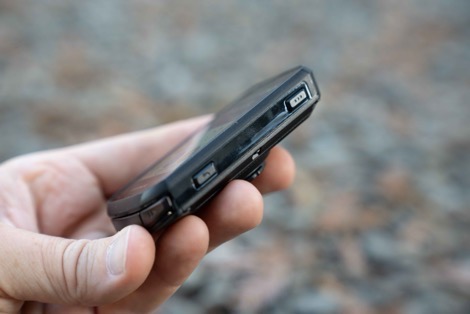
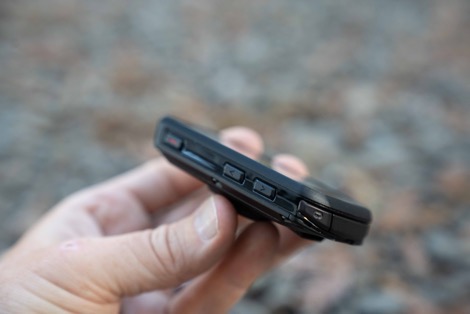

Meanwhile, the touchscreen seems pretty much the same as the Edge 1050 series. It works great when dry, and so-so when wet. It worked better than both the Hammerhead Karoo 3 & Wahoo ROAM 3 when wet, but still made some errors. The ROAM 3 touchscreen was entirely unusable when wet, though the Karoo 3 was closer to the Edge 850. Given how easy the buttons are, it’s just not a big deal to swap to using buttons if the wetness is causing a problem.
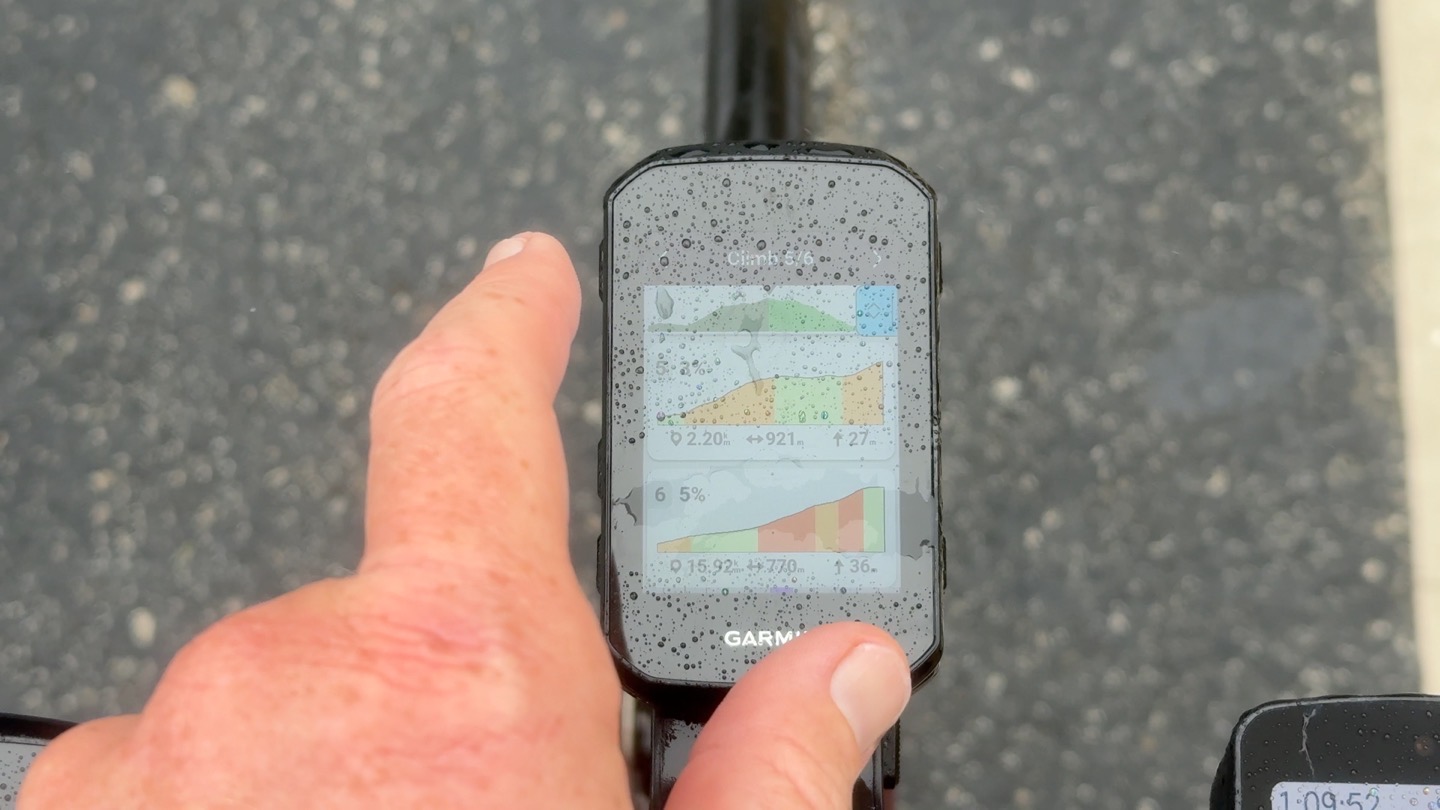
I will note that general sweat/wetness isn’t an issue for me. As a heavy sweater, there have been no problems there. It’s only when the entire screen is covered in water that it’s trickier. That said, this is one advantage of the Edge 850 over the Edge 1050 – the Edge 1050 doesn’t have the side buttons to mitigate any rougher watery situations. Still, I find the Edge 1050’s larger screen makes it a bit easier to get around with wet fingers/gloves than the Edge 850’s slightly smaller screen.
In any event, on the main page, you’ve got your sport profile up top, followed by the last ‘thing’ synced to your device (could be a course, workout, etc…). You can swipe left/right on either of those two levels to switch modes or courses/workouts synced.
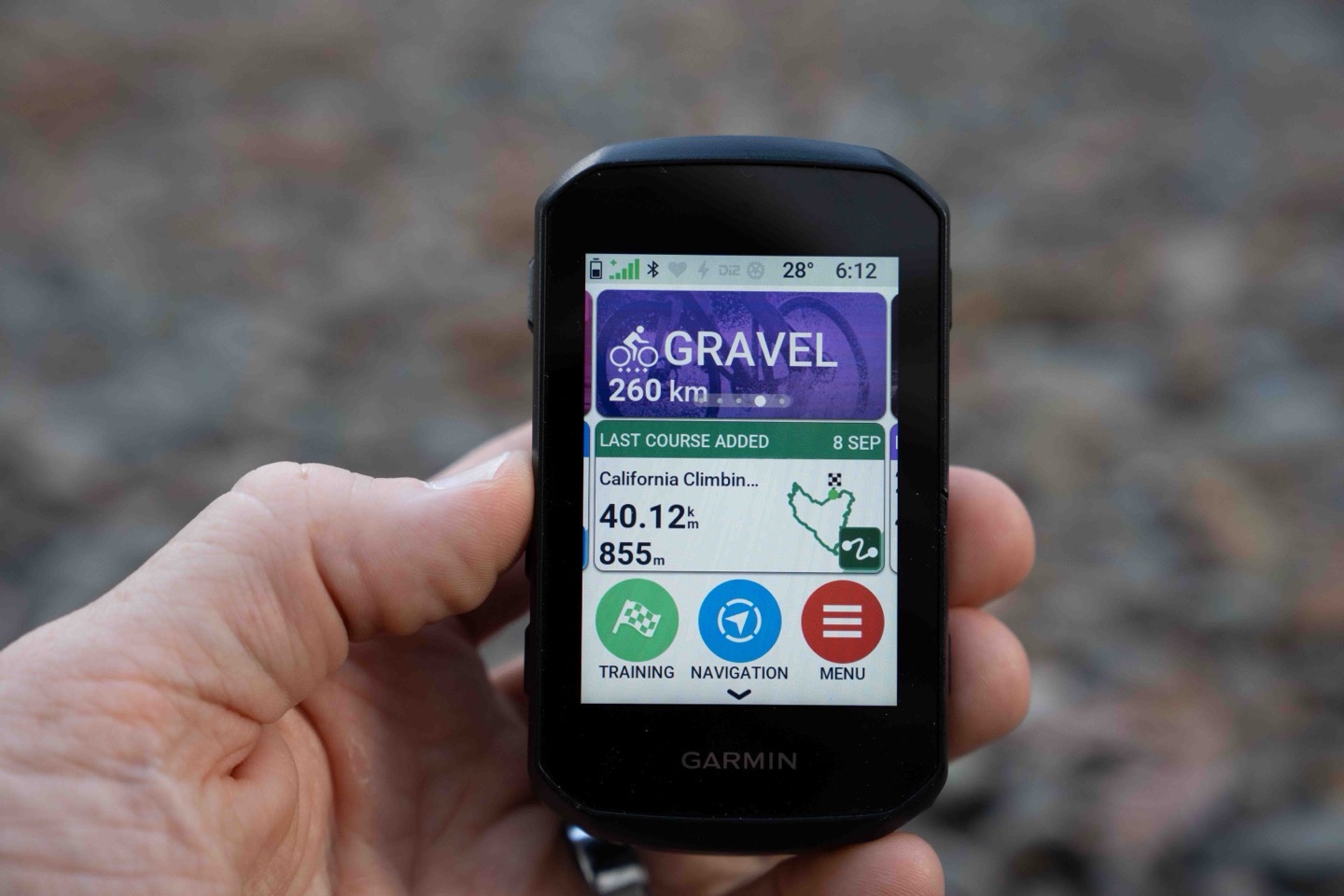
Down below that are the main areas of the device. Starting with Training, you’ll see planned workouts, structured workouts you’ve created/synced from other platforms, segments, intervals, smart trainer control, racing past activities, and more.
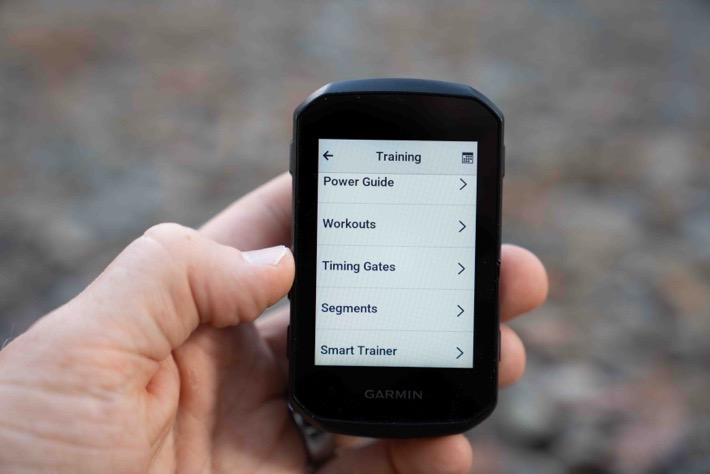
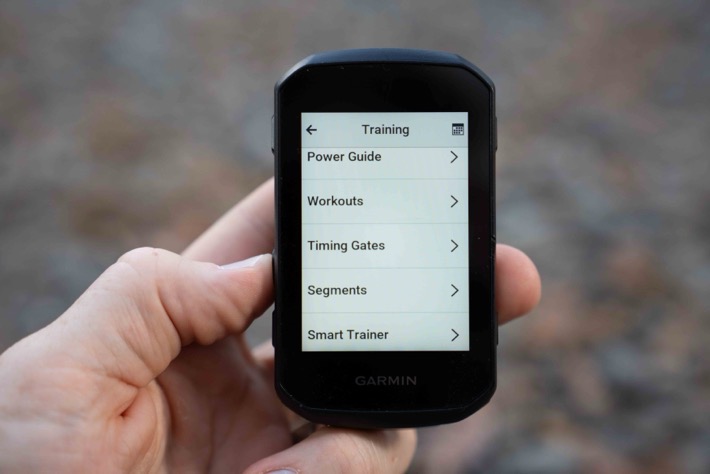
All of this is essentially the same as it’s been for years. Though there are some minor tweaks to Power Guide that I cover in the navigation section.
Heading back, you’ve got the ‘Navigation’ section. That’s where you can browse the map, load up a course, search through POIs (e.g., for a cafe), saved locations, and more.
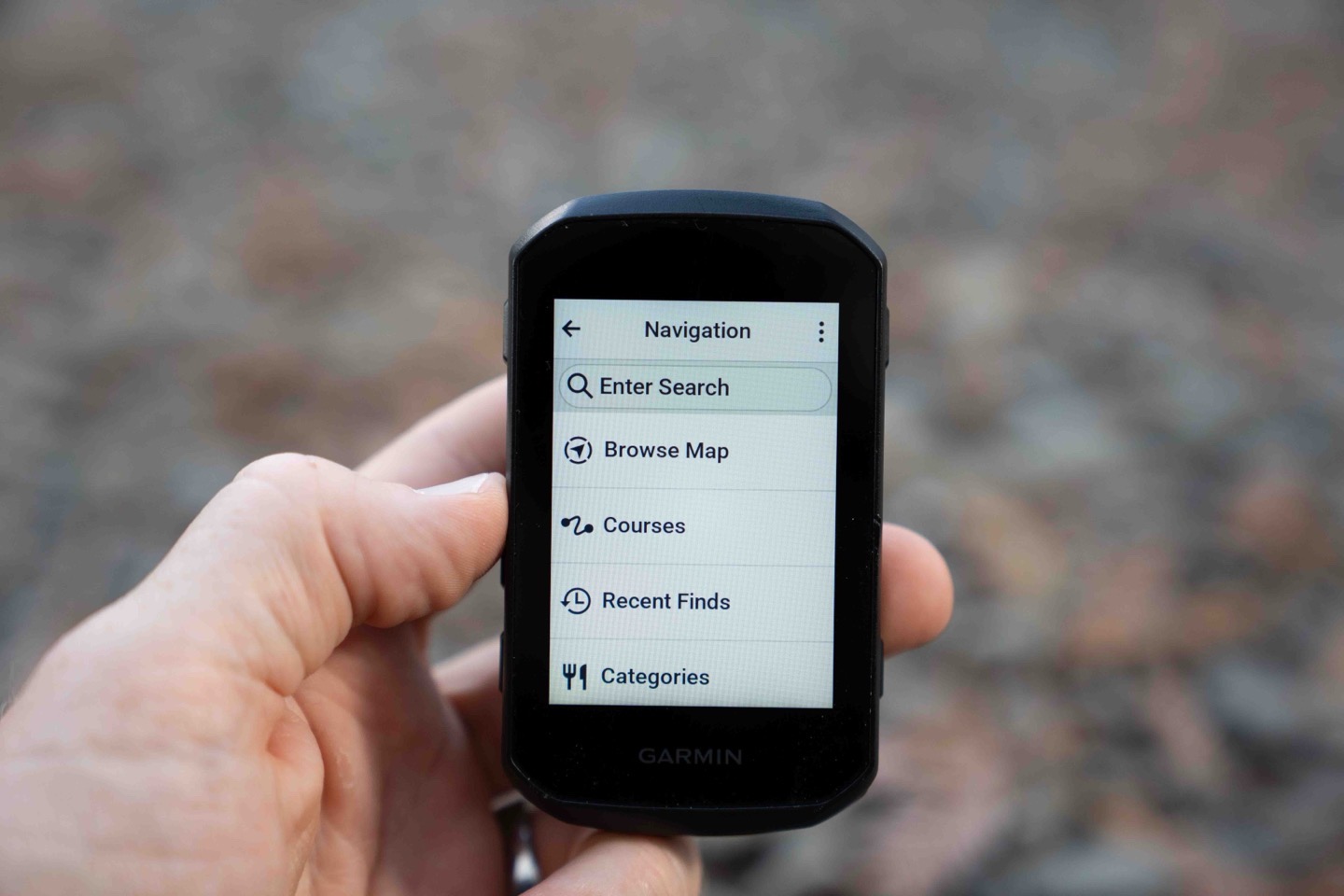
Again, I dive into this more in the ‘Navigation’ section down below.
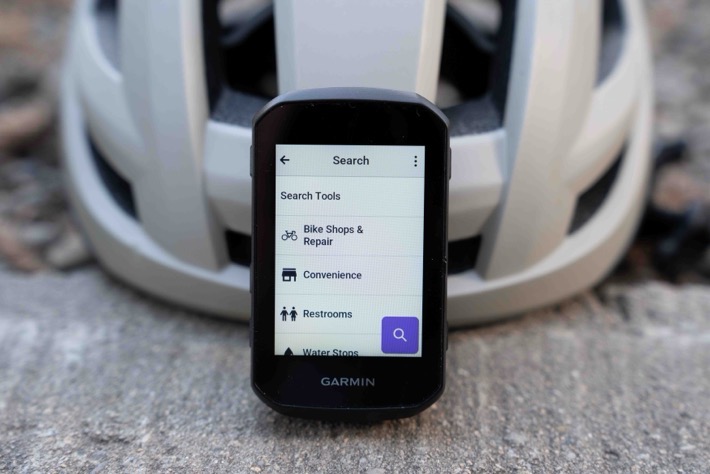
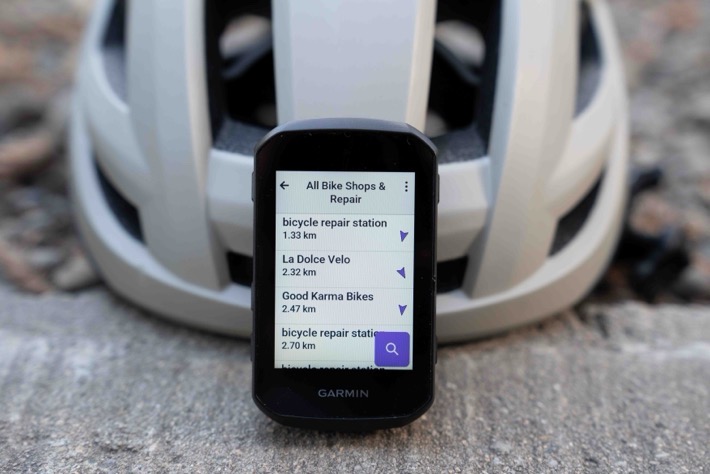
Meanwhile, if you swipe from the top at any time, you’ve got a controls panel. The first page is general status, for things like the backlight, battery, GPS status/type, sensors, and phone status:
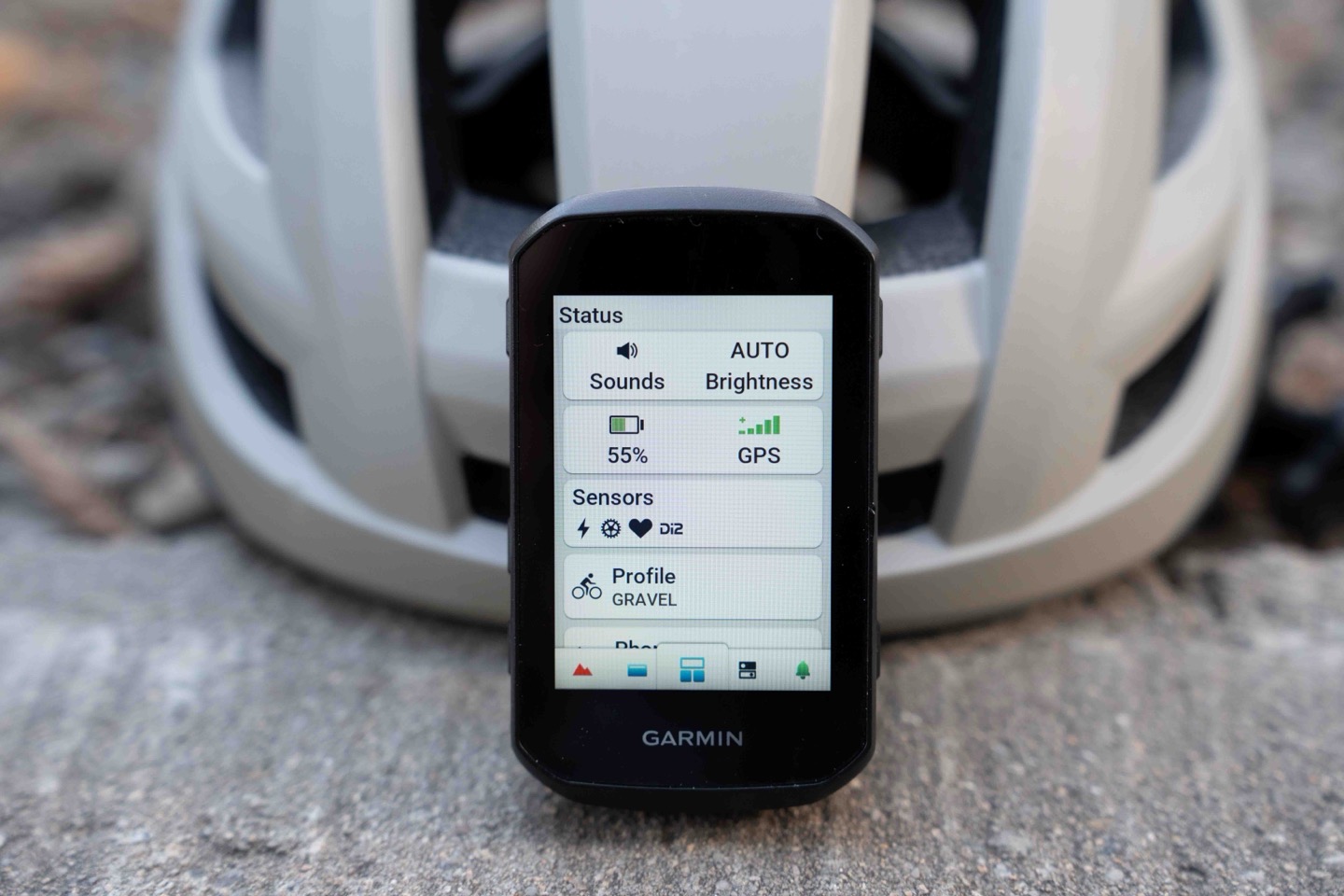
You can then swipe left/right through the different pages: Wallet, Climb Explore, Strava Segment Explore, Weather, Notifications, and other controls (Bike Alarm, finding course, timing gates, workout, etc..):
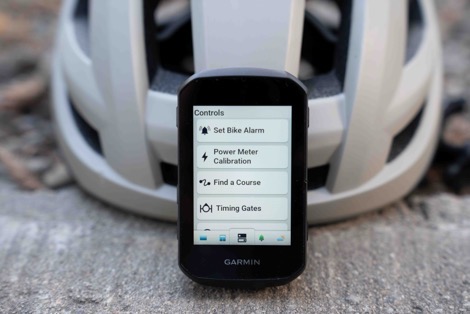
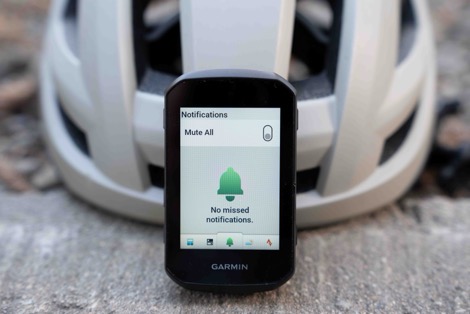

If we look at the weather one, that starts off similar to the past, letting you see the current weather and upcoming weather. However, you’ll notice a new ‘Weather Map’ option, which you tap into:
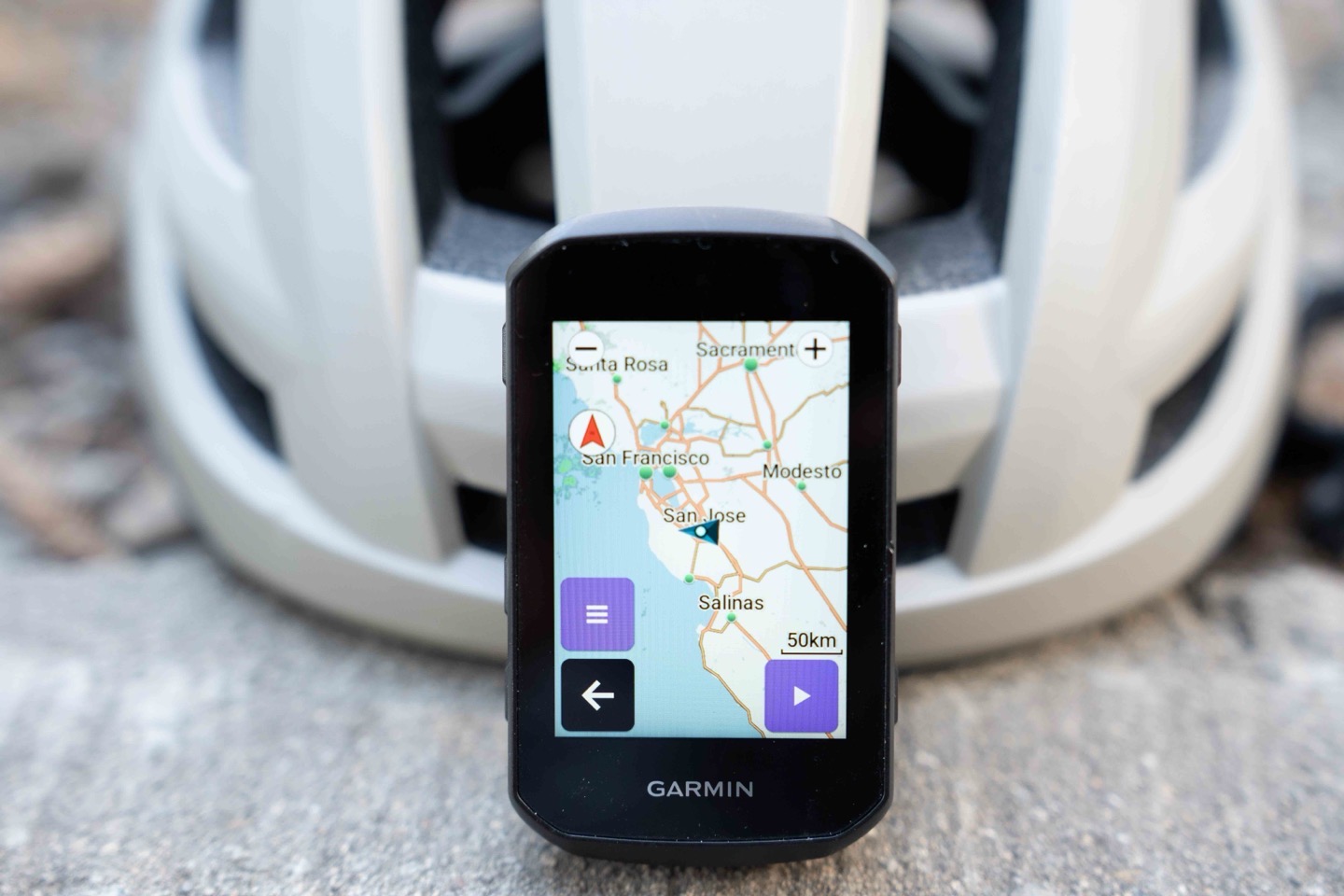
When you do that, you’ll see overlays for wind, precipitation, clouds, and temperature:

Here’s an example of these:
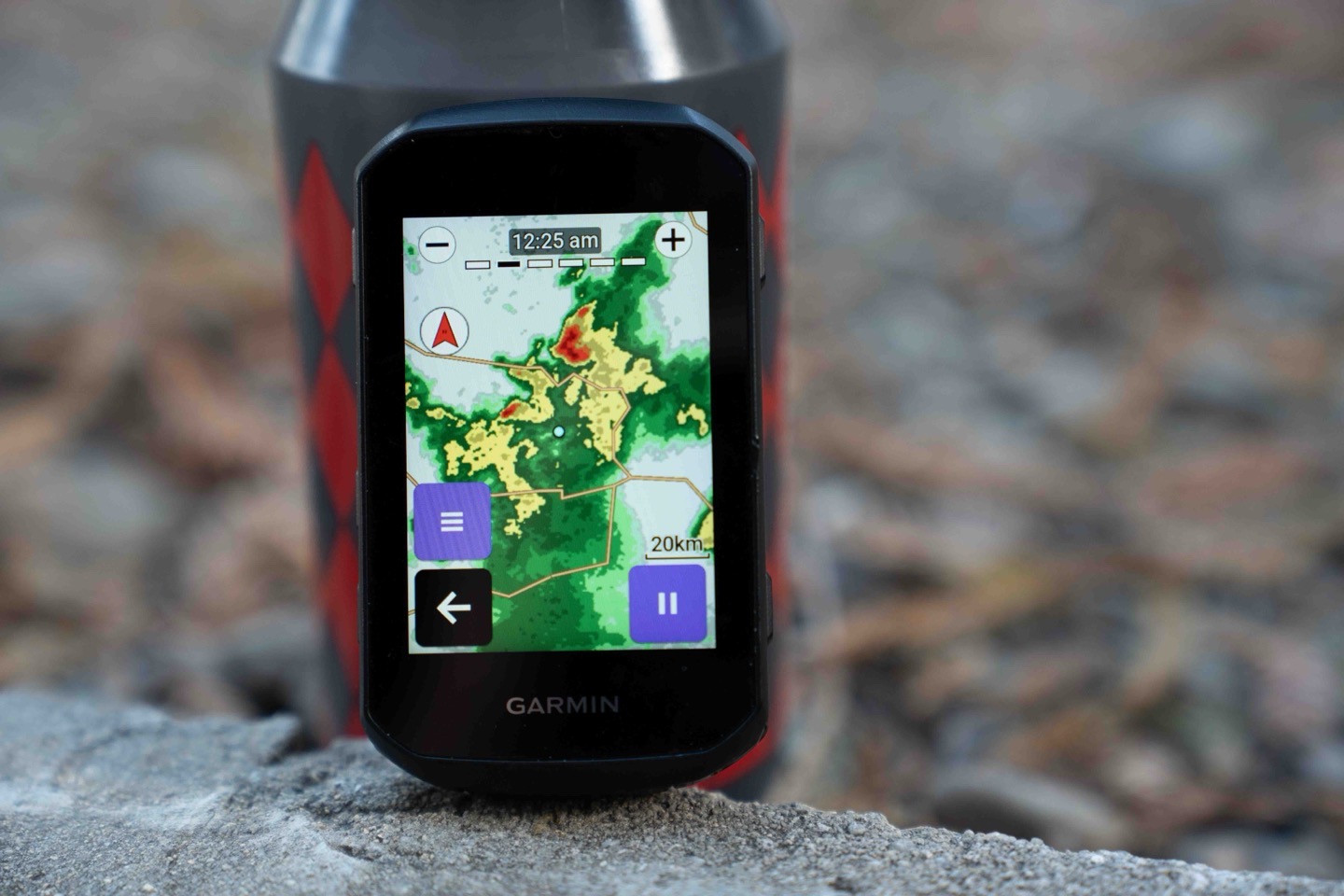
There are actually animations for these too, just like you’ve seen on the Garmin Fenix series for a few years. I show that in the video up above at the top of the post.
While I’d love to see these on the regular map page (versus just this small page), it sounds like that’s a blend of both a processing concern and a battery life concern. The existing map page is already the most battery-heavy thing on the unit, and thus adding a thunderstorm front overlay animation to it isn’t exactly helping the battery.
In any event, back on the main page, you’ve got the menu for settings, and a gazillion other areas. I’ve got a full beginner’s guide coming up here later this week where I’ll dive into all this stuff, though it’s essentially identical to the Edge 1050.
The main thing you’d want to know is that you’ve got Activity Profiles, which you can customize for your different ride types (e.g., road, gravel, MTB, etc…). You can also create your own and customize those, too.

Within these, you can customize all your data pages, data fields, and a dozen other settings.
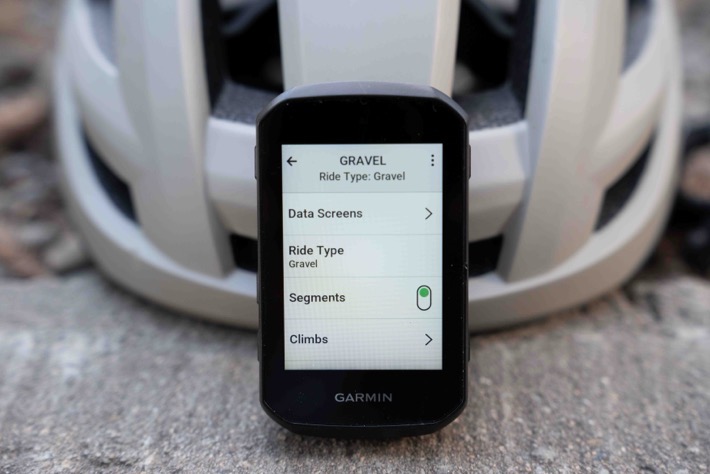
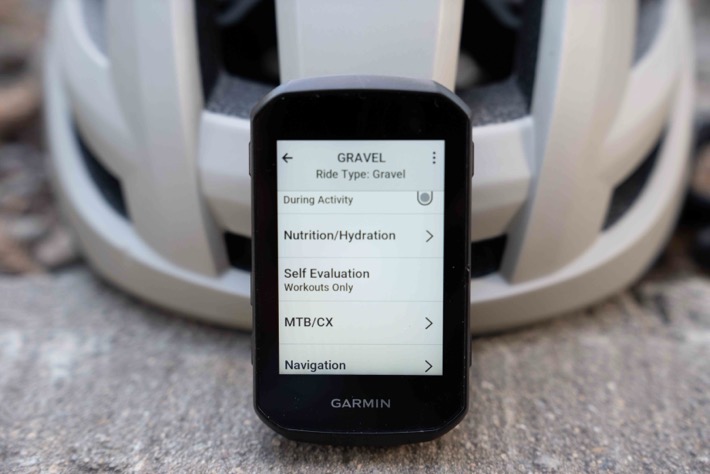
As always, Garmin goes deep on settings/customization. It’s sorta their jam.
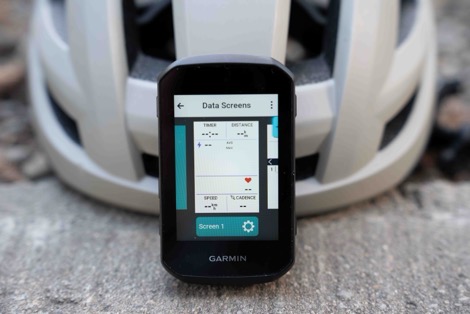
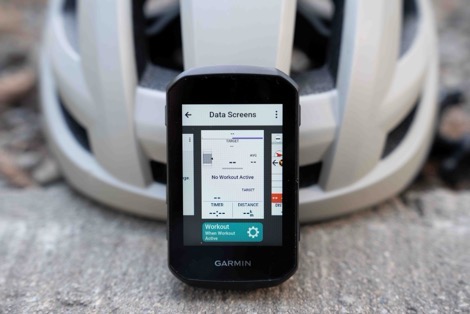
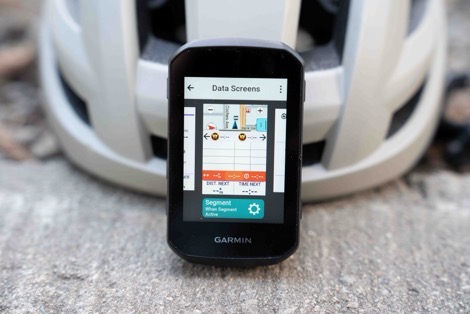
With all that done, you can normally just turn on the unit, and then tap the ride profile at the top. At that point, you’re on your data pages and ready to press the start button in the lower right corner. It usually finds GPS within a few seconds of powering on, well before you get around to hitting start.
Once riding, you’ll see your data pages as you’ve configured them. Here are a few of those from some of my rides:

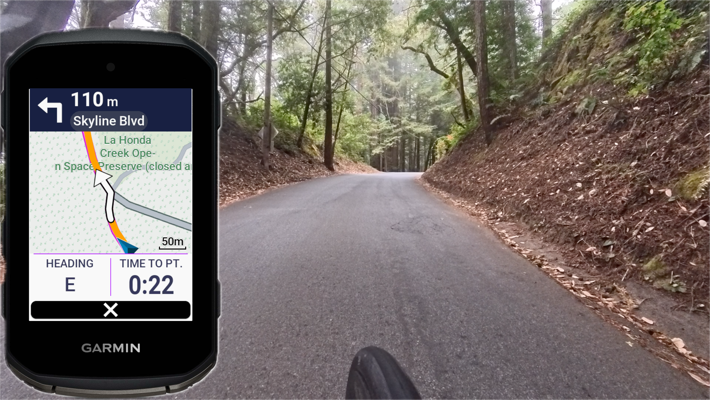
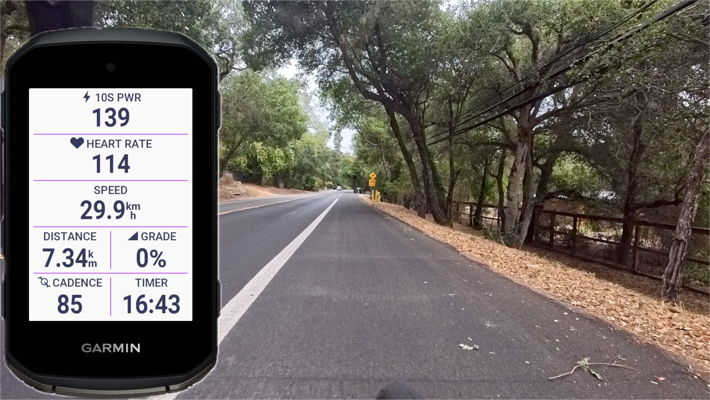
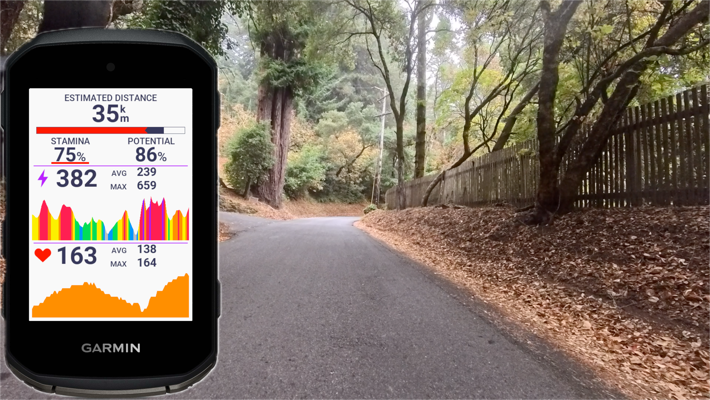
With the ride complete, you’ll get a slate of summary screens, and then your ride is also available on Garmin Connect via Bluetooth or WiFi. From there it’s on to any platforms you’ve configured like Strava, TrainingPeaks, etc…
Lastly, there is the new Garmin Pay inclusion. Of course, there’s been Garmin Pay on Garmin devices for years, but now it’s also on the Edge 850, too. You’ll need to ensure your issuing bank supports it, and then you can use the Garmin Connect app to enable it on your Edge. Once that’s done, you’ll swipe down from the top controls menu to access your wallet:

From there, you’ll unlock it using the PIN code you assigned:
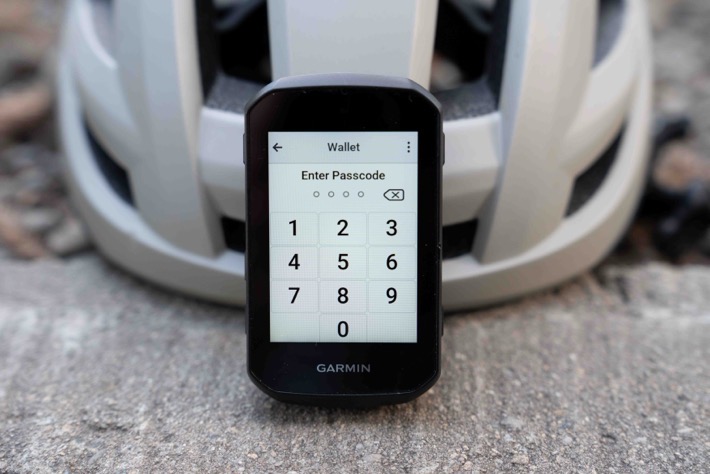
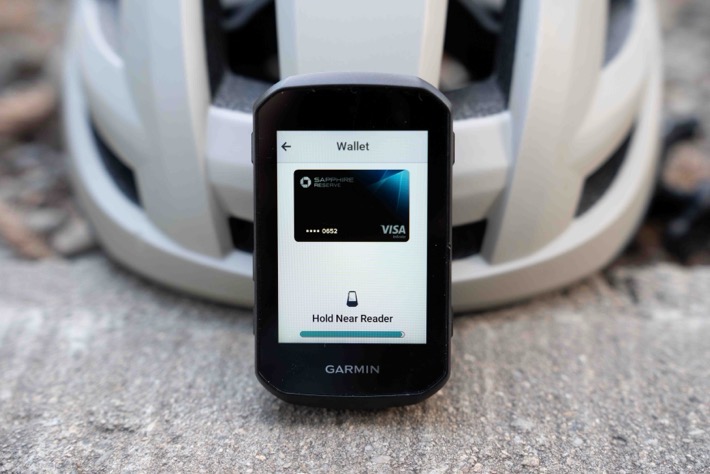
And then it’s ready to make a payment for that mid/post-ride snack:
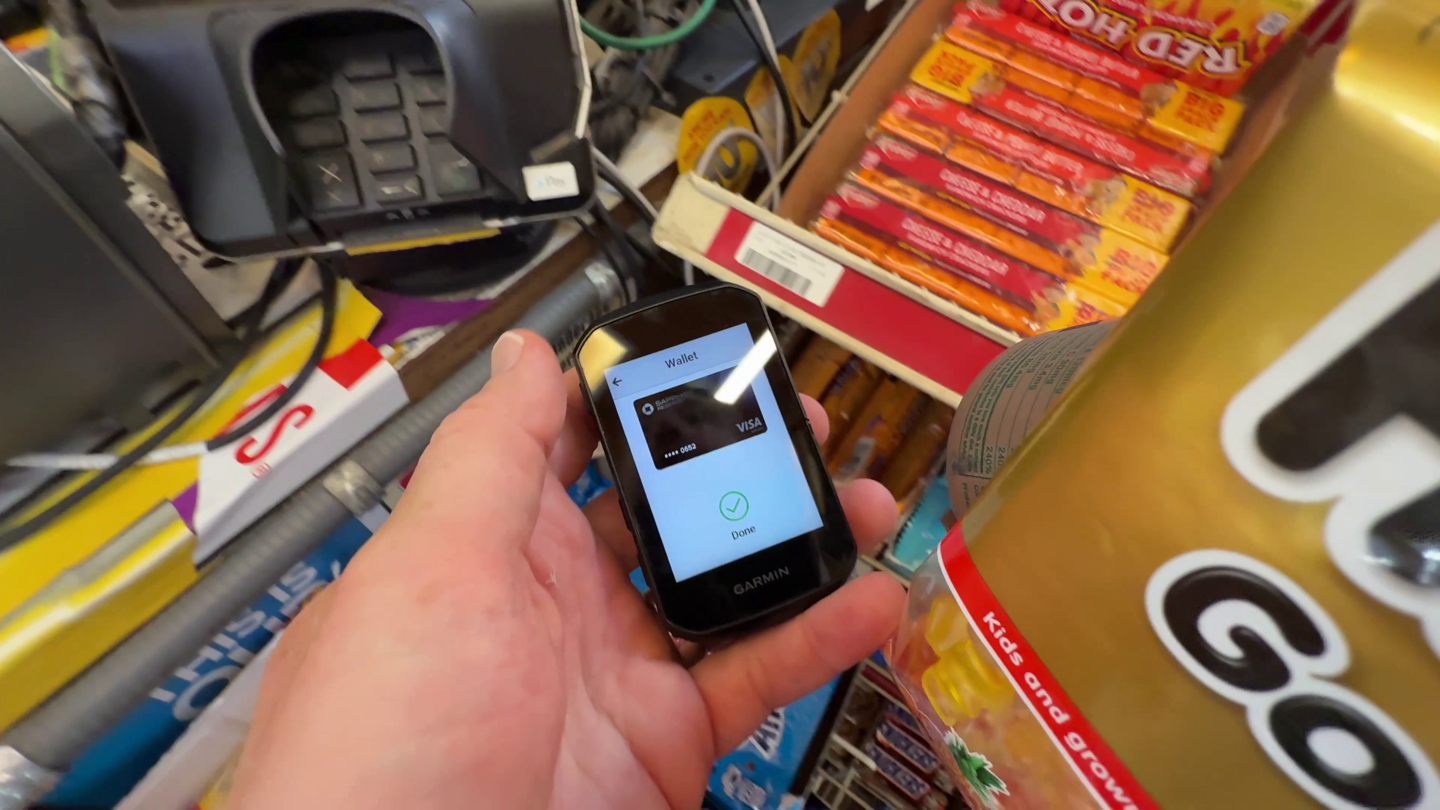
This worked flawlessly for me. Of course, most riders have their phones, but just like with watch NFC payments, it’s just handy to have a backup in case your phone dies. For whatever reason, Garmin decided that the $500 Edge 550 doesn’t deserve this feature, which is kinda funny given Garmin puts it on watches that are half the cost. Sigh.
In any case, with all these basics covered, let’s dive into some of the other new features.
Bike Bell, Voice Prompts, and Speaker Bits:
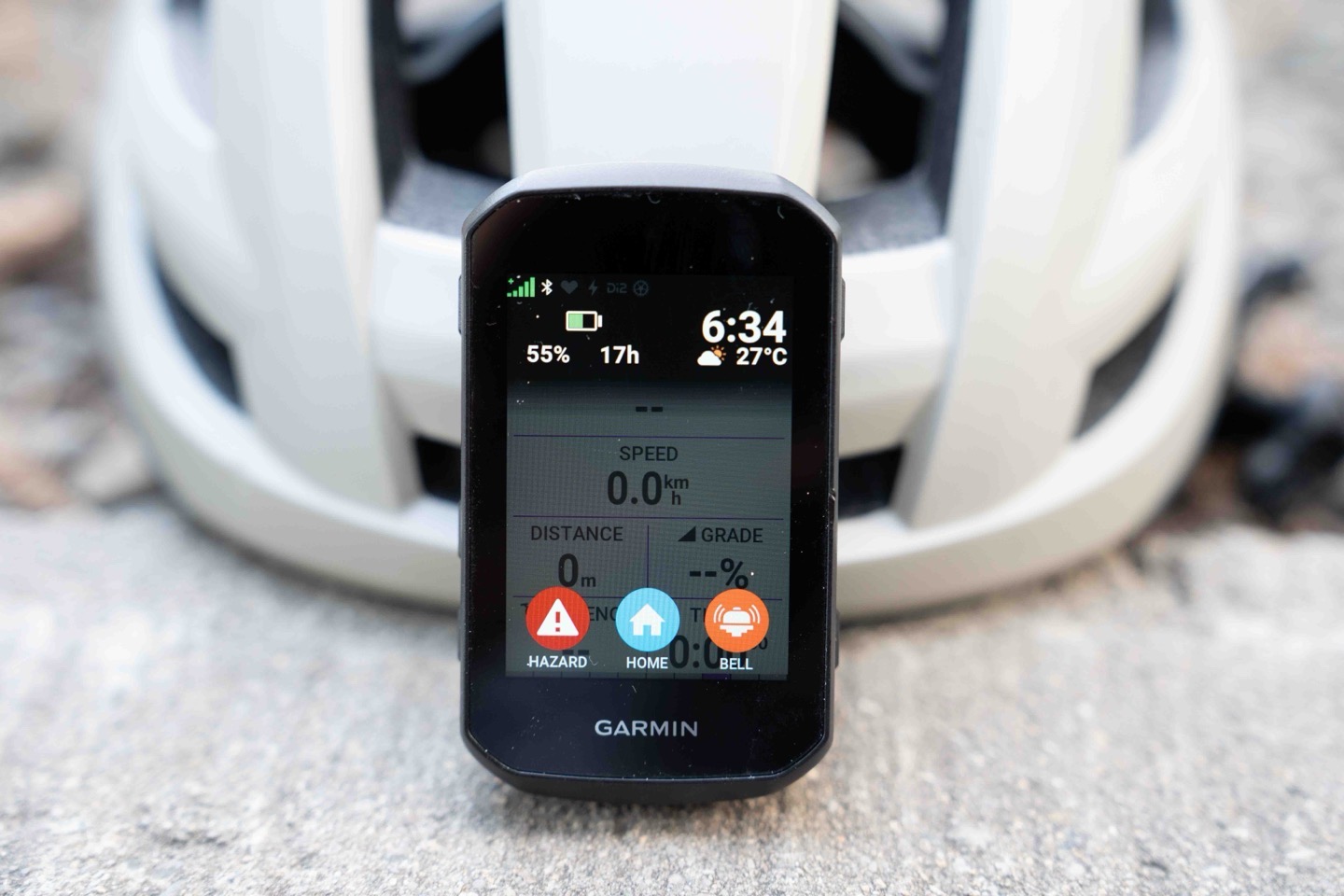
The Edge 850 has a new speaker in it, which is different than the beeper previously. This matches the Edge 1050 in that the speaker enables the bike bell, voice prompts, and other pretty-sounding chimes.
To begin, you can control the different volume levels inside the settings:
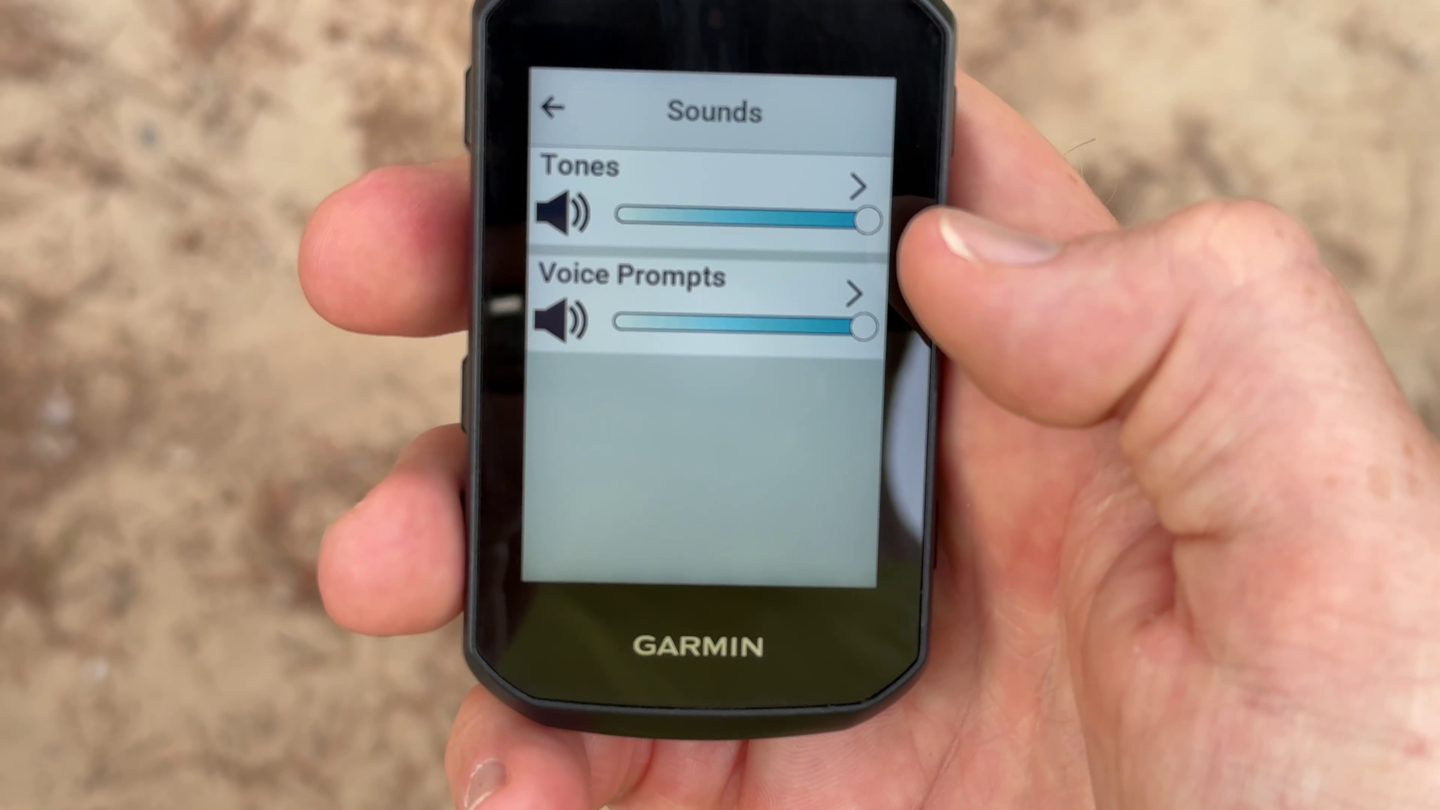
What’s notable here is that you can also control which things it uses voice for, and which things it doesn’t:
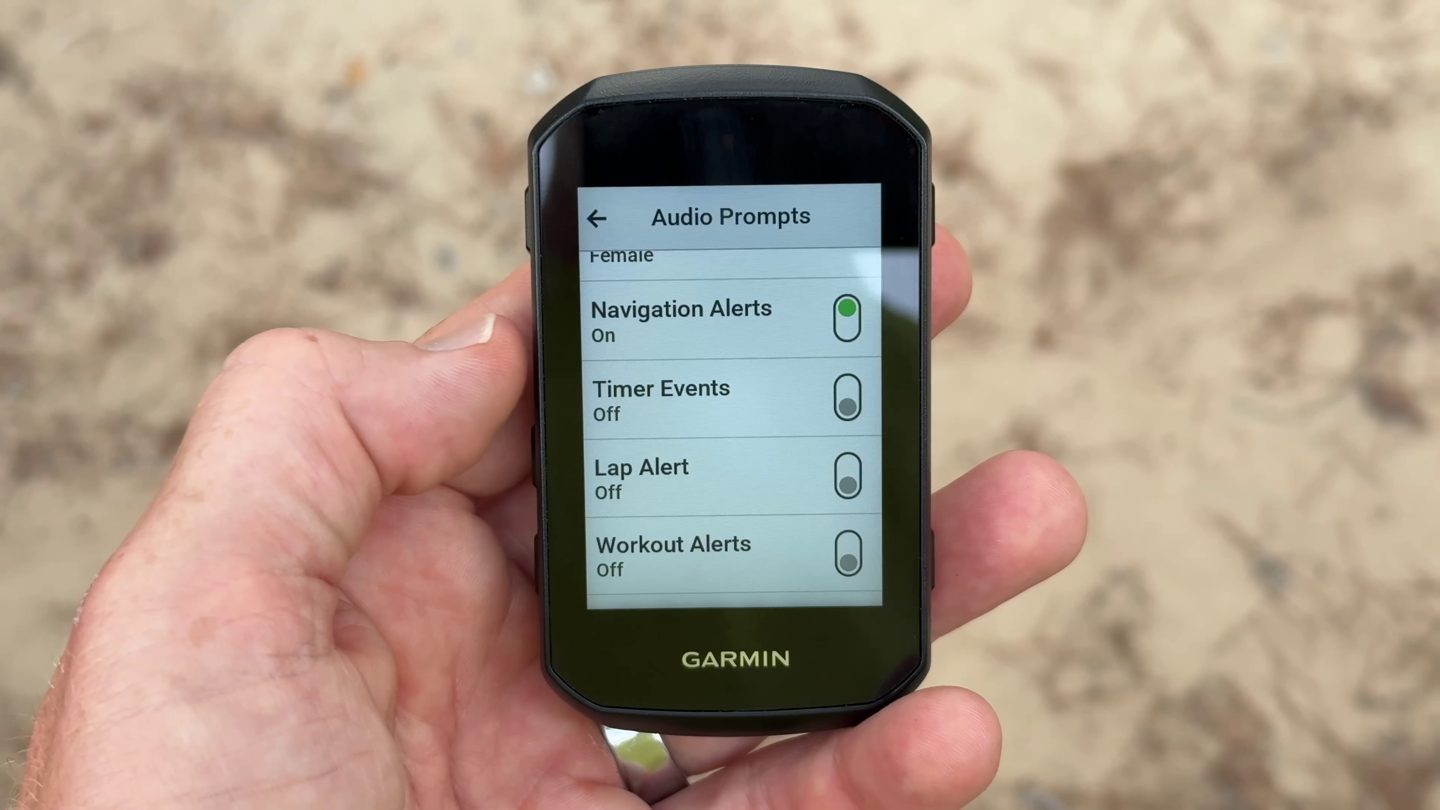
So if you (or your ride buddies) don’t want to hear spoken voice turns or such, you can simply turn those off. I don’t mind the voice prompts. You’ll still get a little chime, and then it just simply tells you a turn is coming, as well as which direction. Nothing intrusive.
Next, of course, is the bike bell. This bell sounds exactly like a real bike bell, and easily tricks even the most well-pedaled Dutch city riding cyclist into thinking it’s just another bike coming from behind.
You can trigger the bike bell by simply tapping the screen once, and then the bike bell icon:
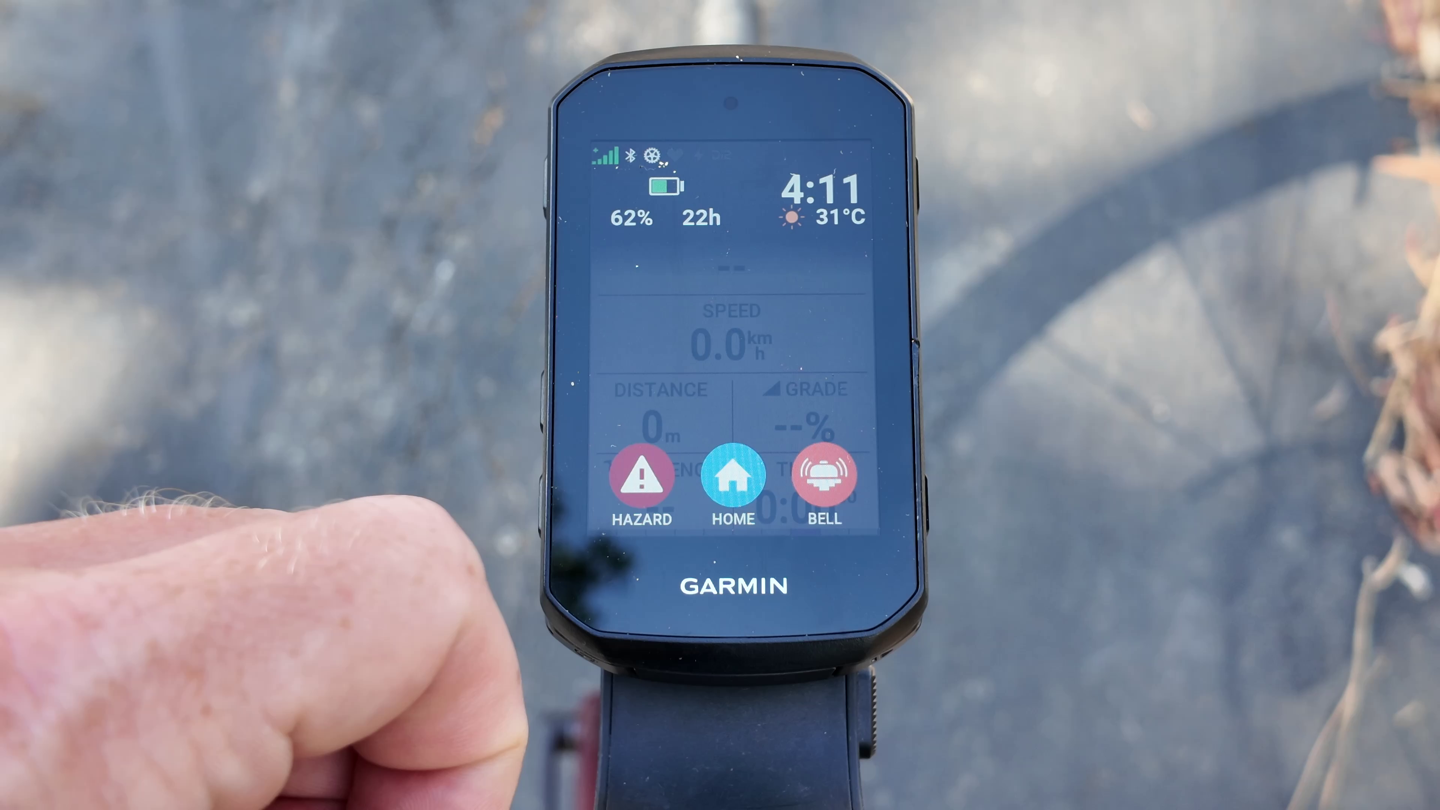
Alternatively, on SRAM AXS with the new bonus button, you can configure that button for the bike bell as well, which is what I do. Technically speaking, you can use any of the extra functions, which you’ll set up within the SRAM AXS app first, and then into the settings of the Edge 850:
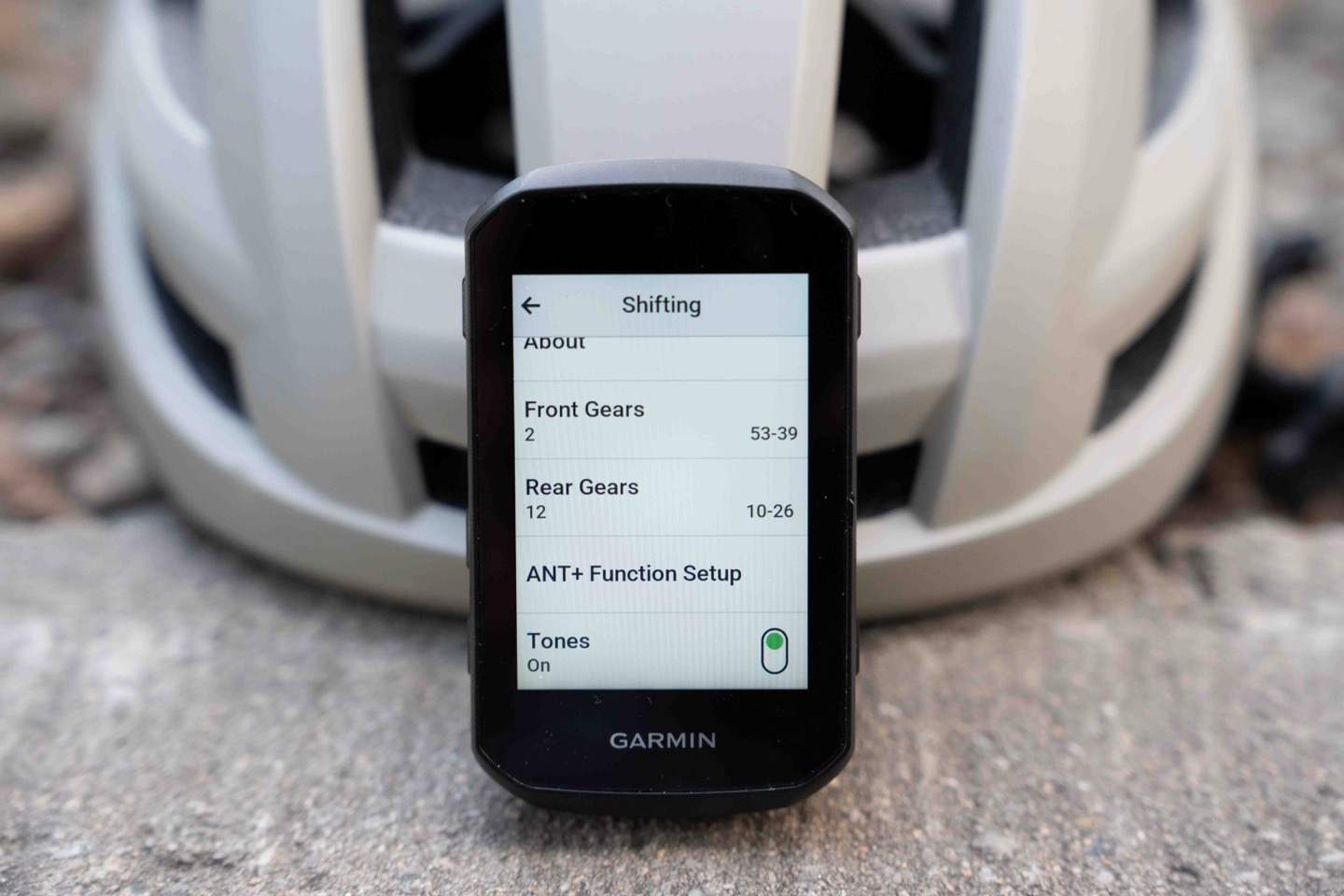
This is super handy, since you can just quickly tap it right from the handlebars without moving your hands anywhere else.
If you have one of those older Garmin Edge remotes (small buttons), you can also trigger it that way. Though sadly, Garmin doesn’t sell them anymore.
Of course, all of this bike bell dinging can also be accomplished by a $3 bike bell, but what’s the fun in that? While I don’t think the speaker is a massive change to your on-bike riding experience as a whole, I think it is a nice upgrade. The sounds are more pleasant, and the overall experience simply feels more refined. In many ways, it’s Garmin taking a page from the Apple playbook of adding refined polish as a way to generate sales. Given it works for the rest of the bike industry too, might as well use it here.
Navigation, Routing, and More:
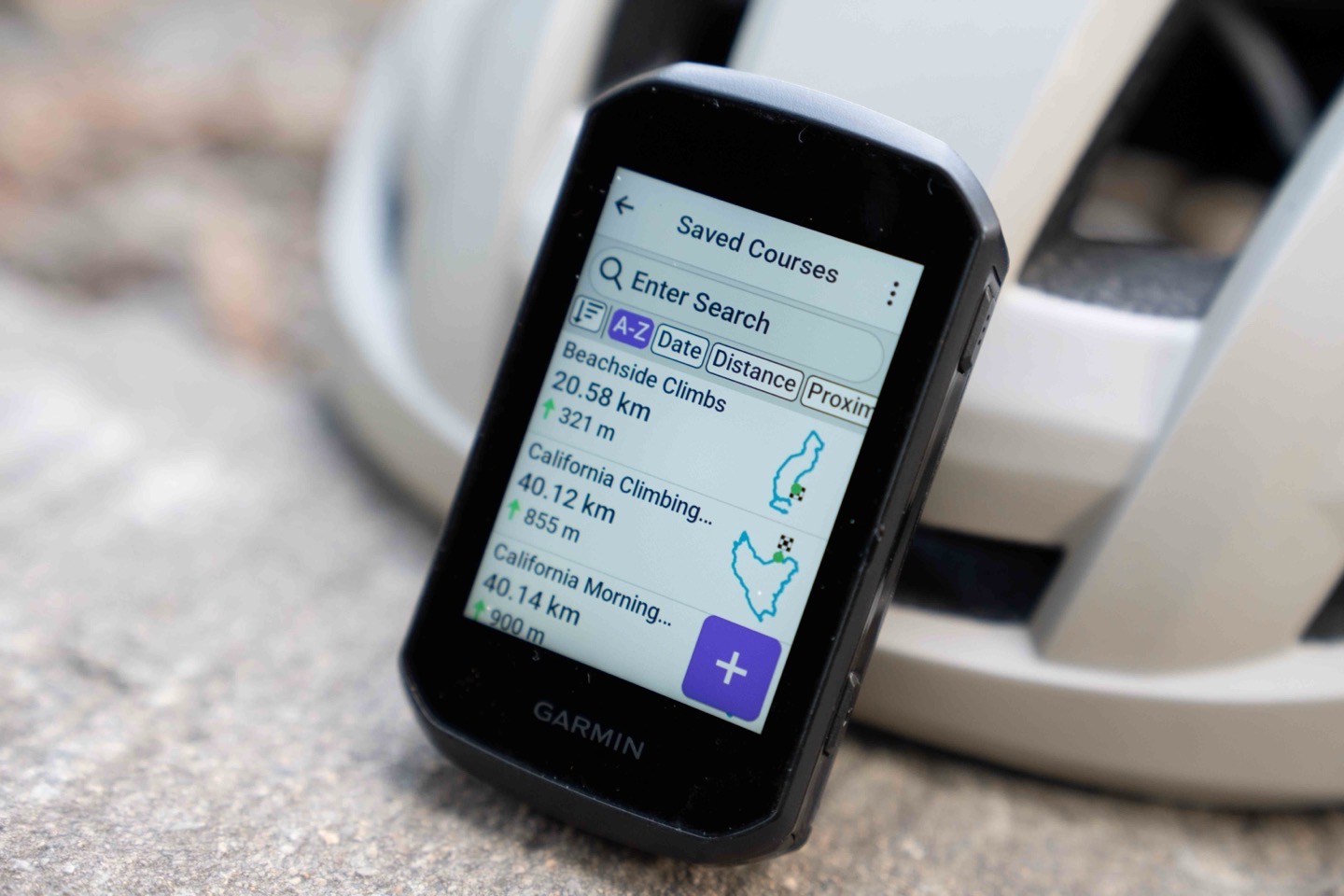
In terms of new features in the mapping/navigation realm, much of this has remained the same. However, with the updated processor, things now render on the maps far faster than before. And also notably, the maps have considerably more detail than before. Route calculation was already substantially improved in more recent Edge 840 firmware, so there’s not a major difference here. There’s really no meaningful time in terms of route calculation; it effectively happens instantly to your eyes (but is offloaded to the background to finish up later portions of the route).
If you watch the video, you can see some of this in terms of speed of panning around and such (check the video for this).
In terms of mapping, fully Garmin TopoActive map downloads continue to be free for the entire globe. However, with the Edge 850 you now get 64GB by default (versus 32GB previously). This allows you to easily download two full regions (notably Europe & North America) without any issues. Generally speaking, you could squish both into the 32GB previously, but this ensures no issues. You can add as many regions as you’d like, assuming it fits.
You can add regions via Garmin Express on a desktop computer (far faster), or via WiFi directly on the unit itself (super slow, basically has to run overnight). TopoActive Europe is 18.9GB, and TopoActive North America is 12.9GB (though, you can load a slightly smaller US-only map, if you download via computer. Same goes for Europe, and breaking it apart.
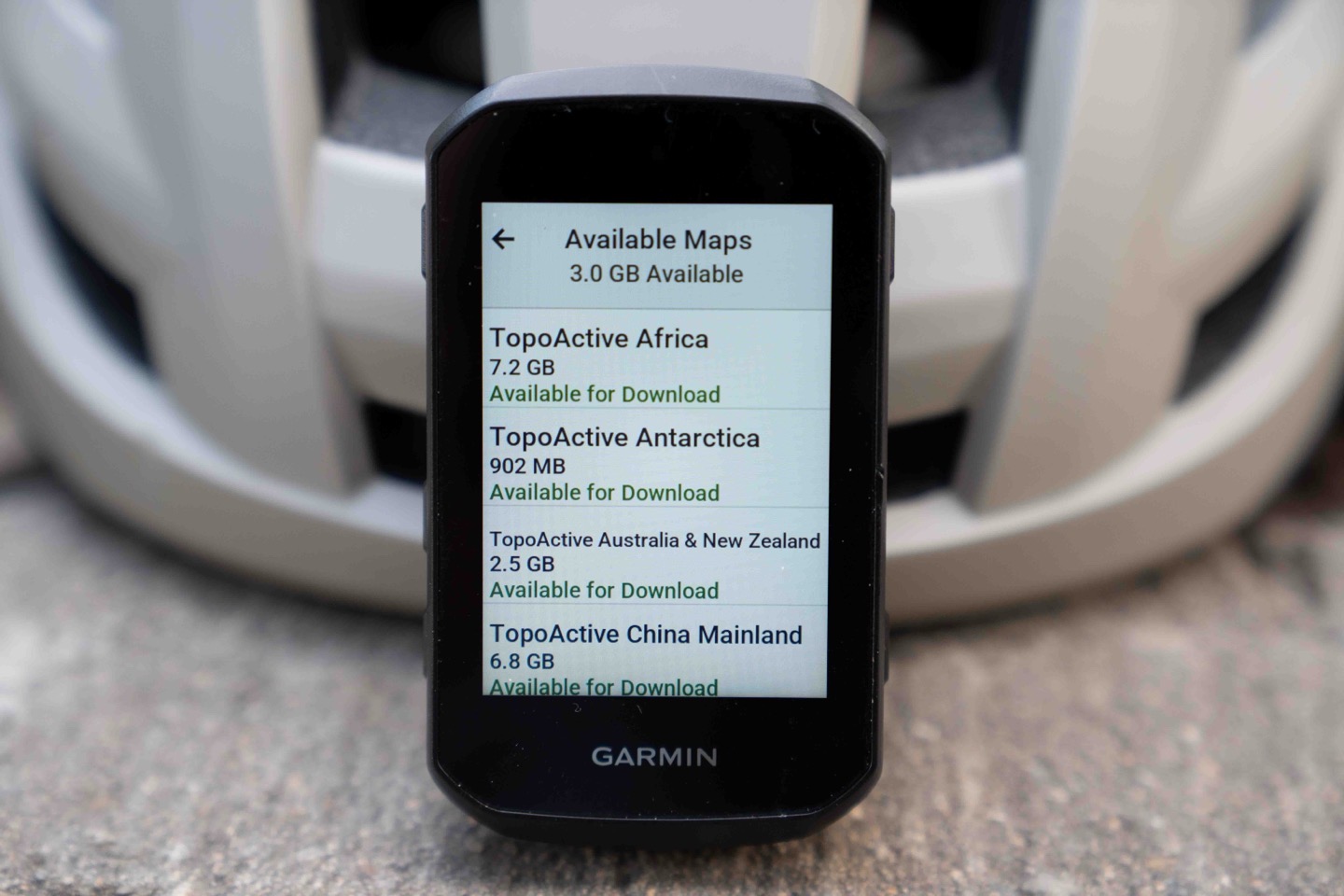
As I keep harping on, this is sorta a pain in the butt when you travel. While I do truly appreciate Garmin offering the single large map size to just take care of the entire continent, I really wish they’d also offer smaller country/regional maps like all their competitors do. It just makes this viable to get maps when you forget to download the maps before landing elsewhere. Plus, it’d seem that undoubtedly save on their internet bandwidth bill, since each map download/update being 10-15GB is pretty substantial compared to a smaller country/region at 300-500MB.
In any case, when it comes to navigation on the Edge 850, you’ve got a few core choices:
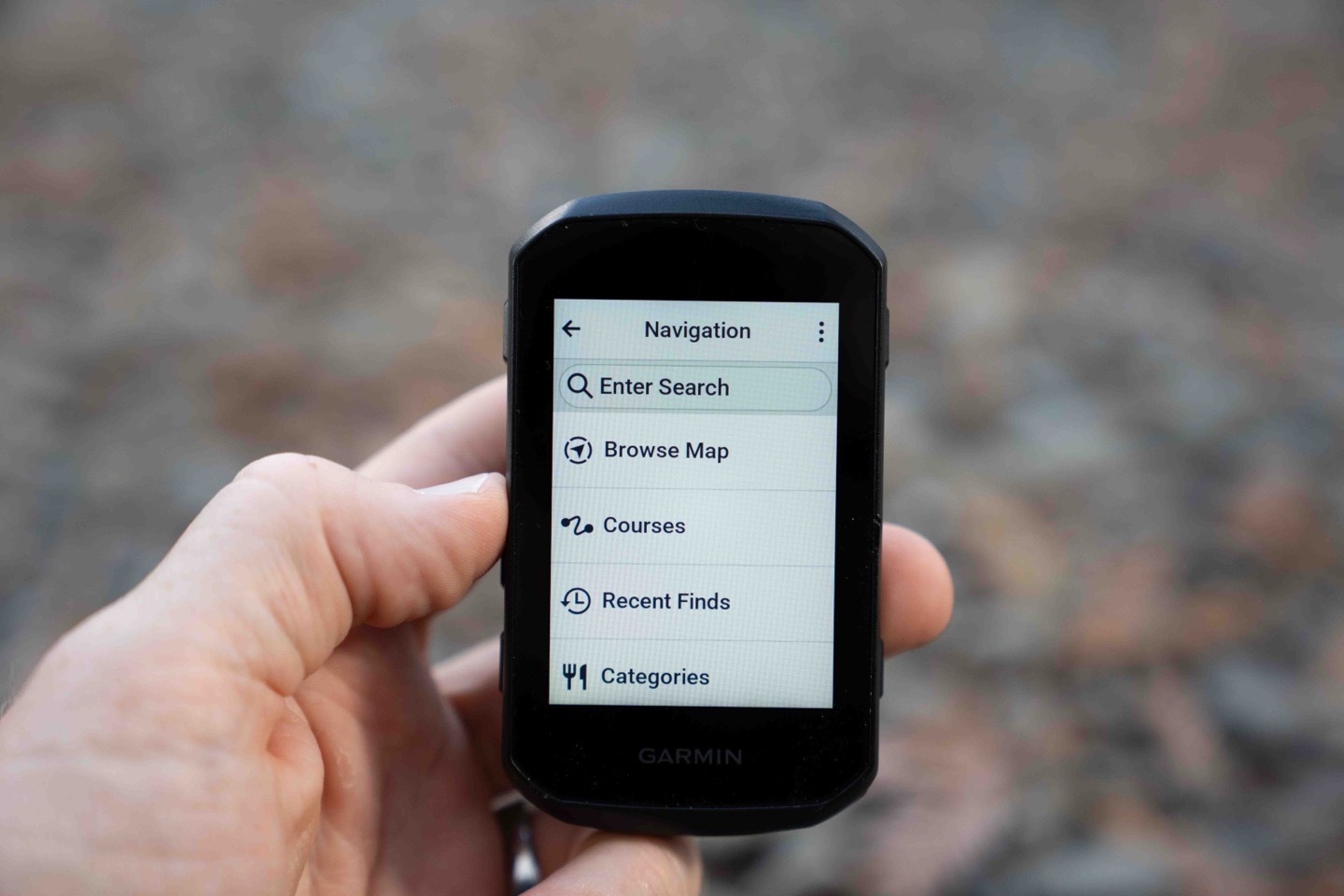
On the Edge 850 you can search for things by name (which you can’t do on the Edge 550), but you can also sift though the POI categories and simply route to POI quickly and easily.
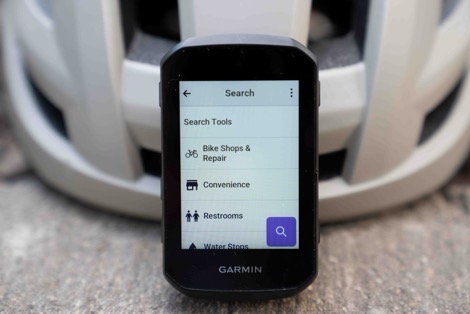
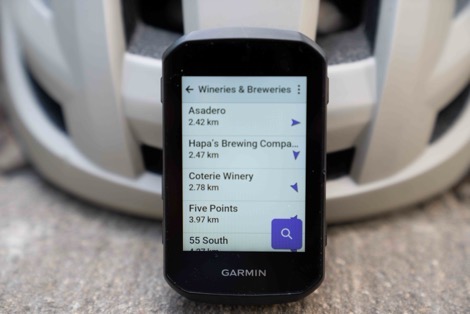
Nonetheless, in approximately 99.994% of the times, I’m creating a route ahead of time on Strava or Komoot (and rarely Garmin Connect, though there’s nothing wrong with it, I just have numerous non-Garmin devices that I sync routes to). Though it should be noted that Garmin has increased the surface types in Garmin Connect recently (e.g. Gravel vs Road), which should help with route planning. Again, the Garmin tools are actually really good, but for my use case in syncing to Garmin/Wahoo/Hammerhead/etc…I just use Strava as my single neutral repository for almost everything.
So, when I create a route on Strava, it automatically syncs to the Edge unit within a few seconds wirelessly, automatically. Here on the Edge 850 it’ll automatically show on the homepage as the most recent synced ‘thing’ (if you had just synced a workout, it’d show that instead, etc…). I can tap the route to load it, or, dive into the Navigation/Courses page to load up other routes I may have.
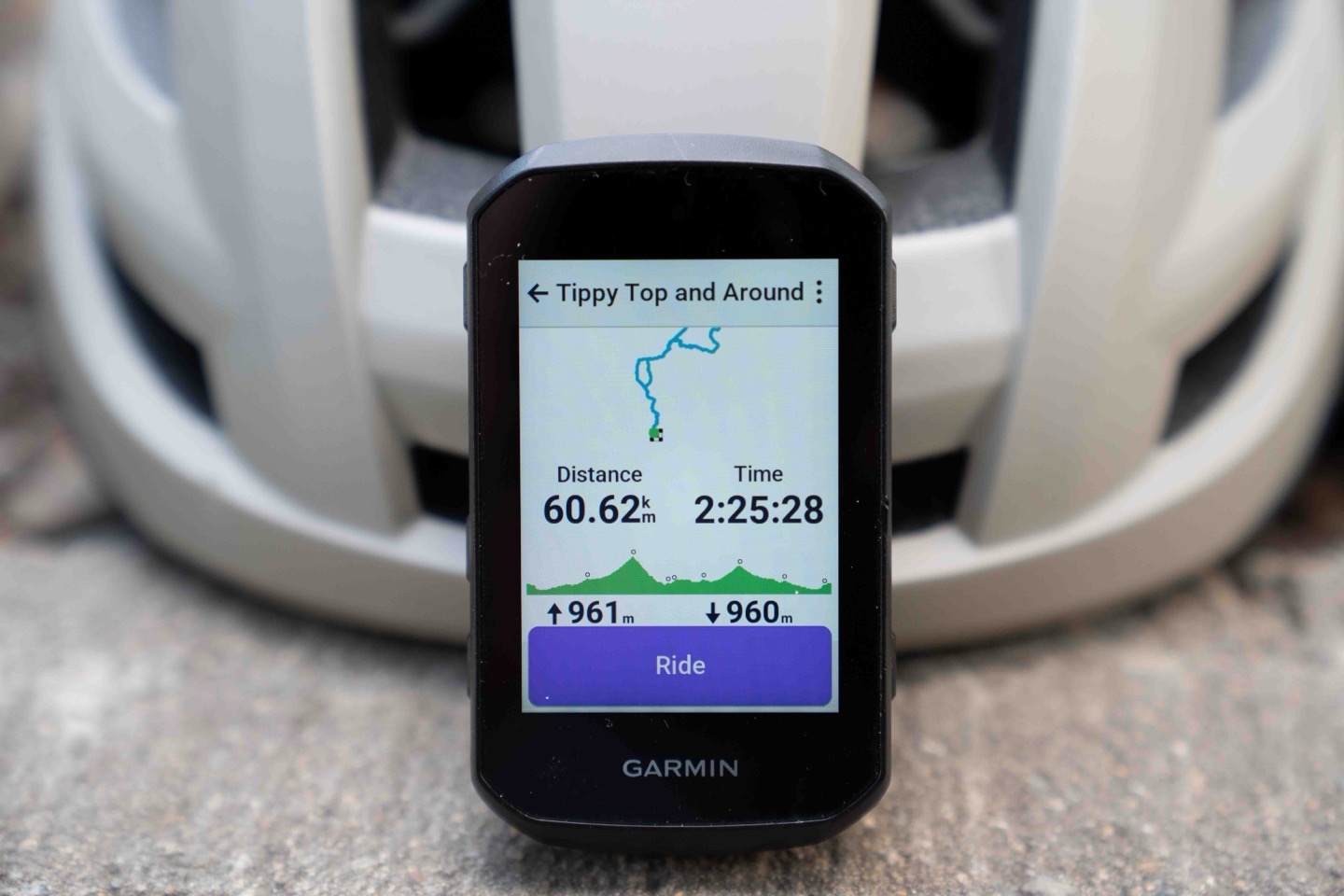
I’m honestly surprised we didn’t see Garmin add some sort of folder structure here. Hammerhead added it a year or so ago, and it’s just so damn good for organizing routes. Especially when you have tons of routes.
Once I select a route, I can see details about it, including the elevation profile, distance, climbs, and more.
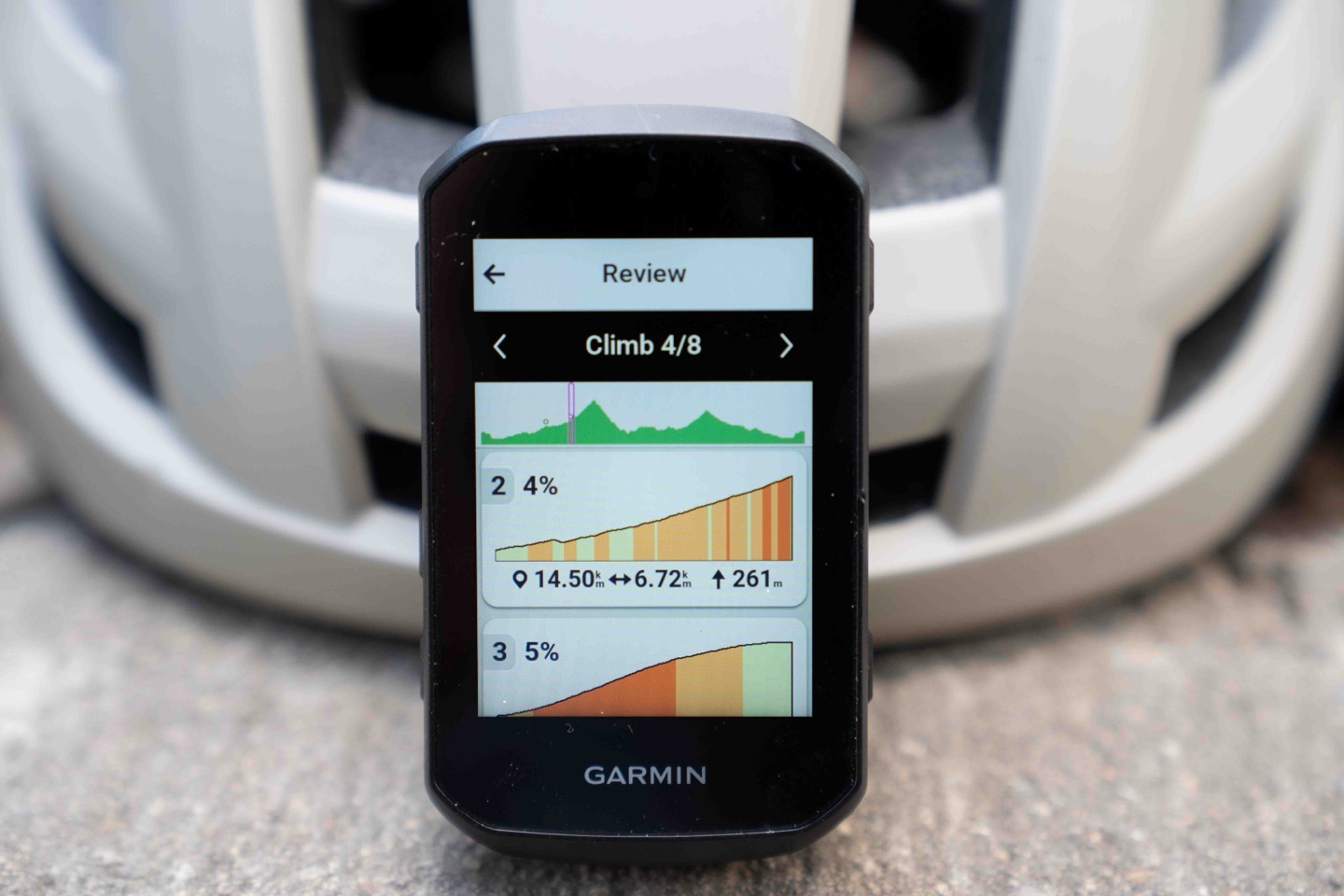
One of the things you’ll see is the nutrition requirements. I don’t really understand why these are so incredibly low. Like, something is hard wrong here:

I should most definitely be eating something on a 40km gravel ride with 3,000ft of climbing on a hot day…and definitely taking more than 400ml of water in total.
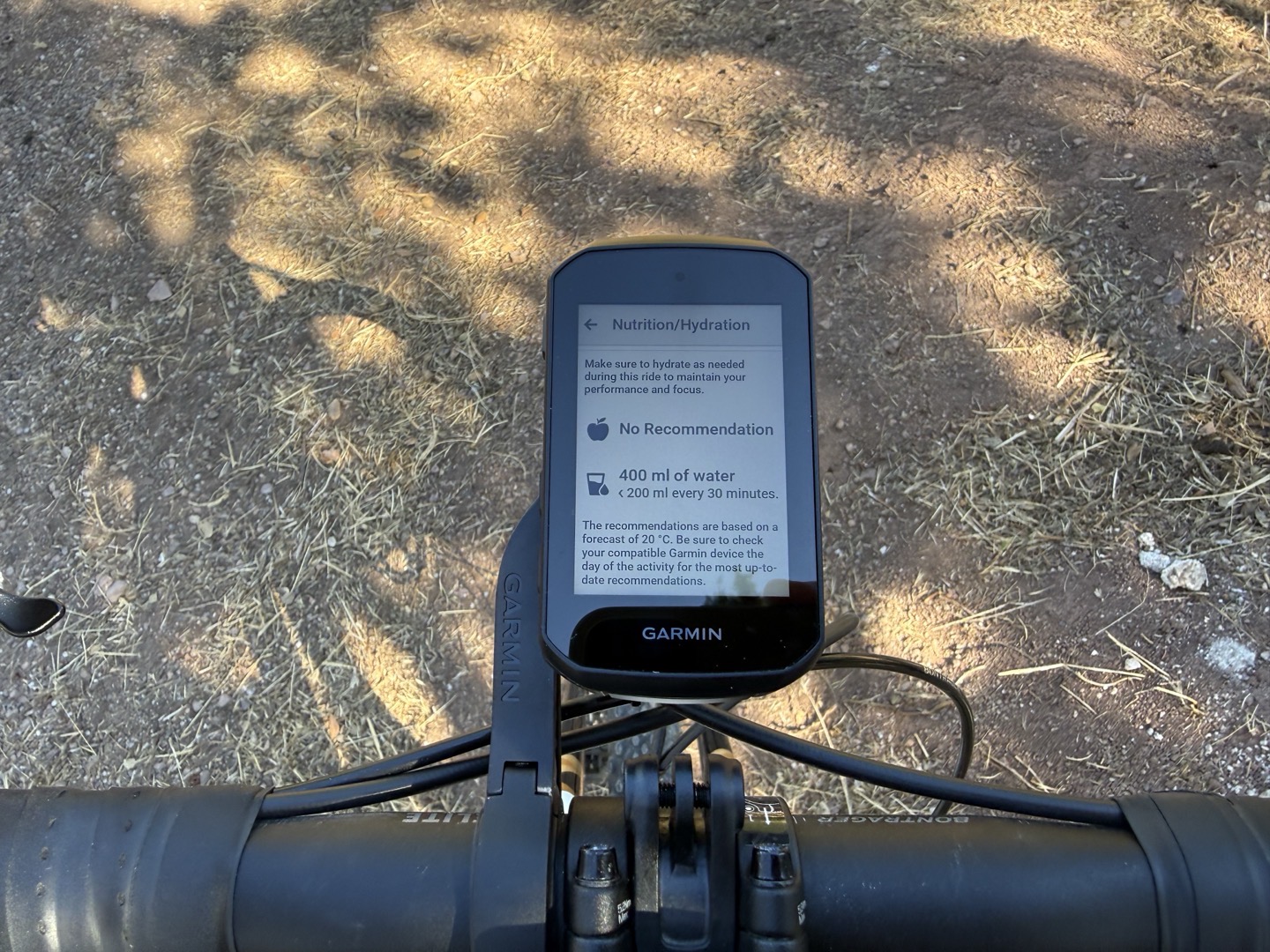
Some rides I’ve had closer amounts for water, like this one here that suggests 3 bottles of water over 2.5 hours on an 80*F+ day. Though, the nutrition side seems pretty low by most modern standards. This is one of the new Edge 550/850 features, but doesn’t seem to be working well somehow.
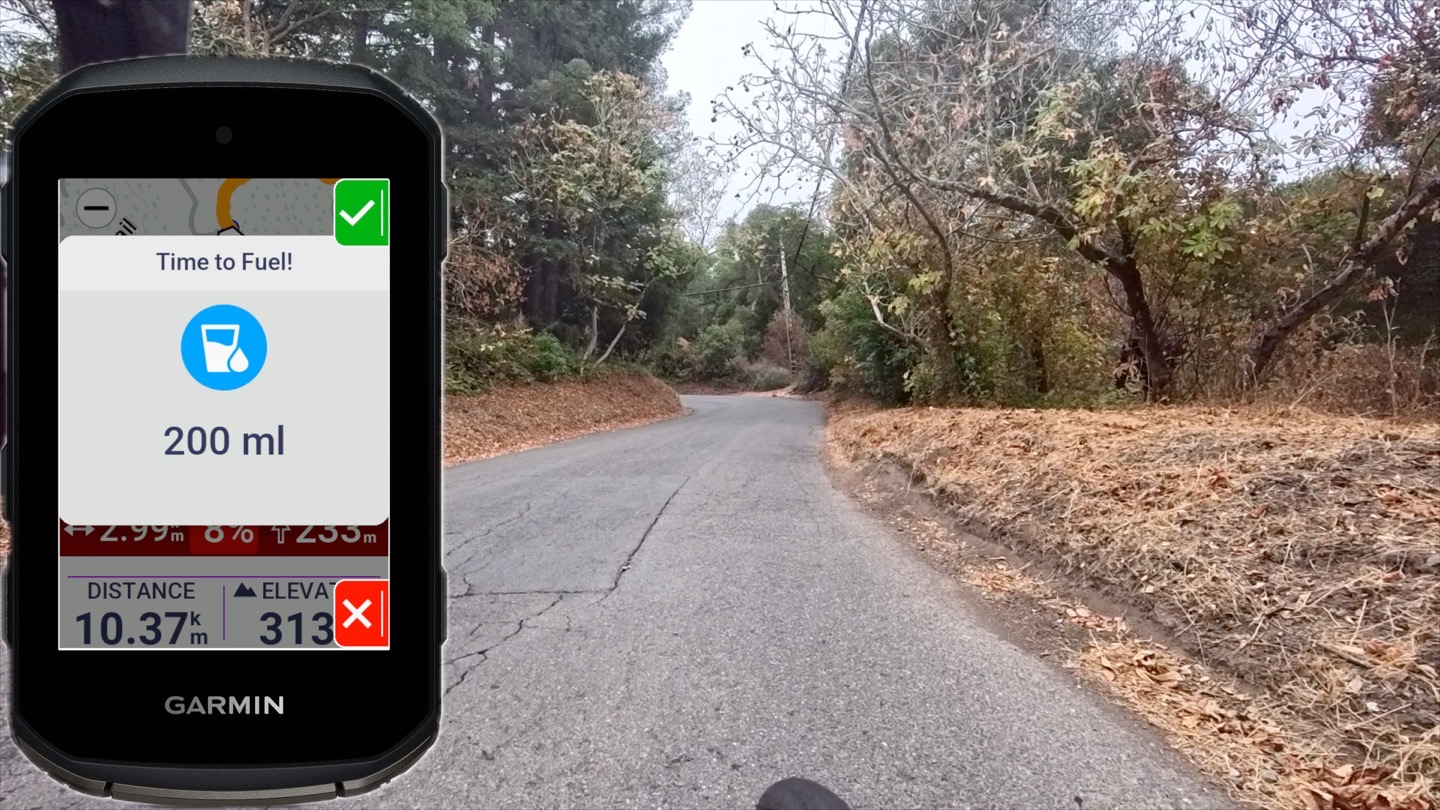
Nonetheless, once you’re ready to start riding, tap the ‘Ride’ button to load up the course. If you’re not at the course start point, it’ll offer to route you there. I generally ignore/skip this if I can just navigate myself to it (e.g. a few blocks away). Once you join the course it’ll automatically start the route and say ‘Course found’. As you ride you’ll get turn prompts as you approach a turn, as well as a mini-map pop-up screen (regardless of which data page you’re on):
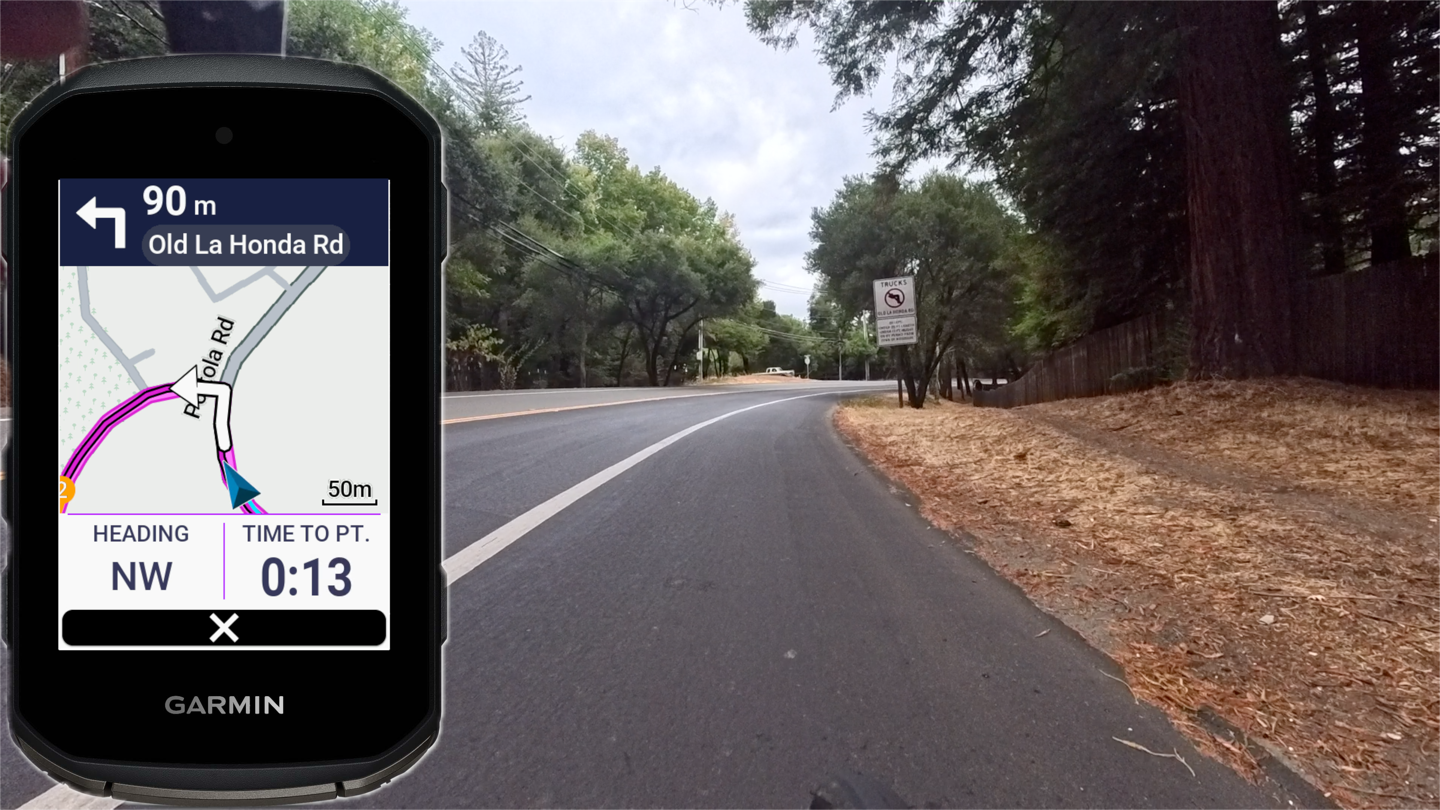
If you were to go off-route, you’d also get automatic re-routing calculations. It’ll first pop-up a box that gives you a chance to pause or end navigation (perhaps you’re just quickly doubling back to grab something you dropped). Else, it’ll just automatically begin to calculate after 10-seconds or so.
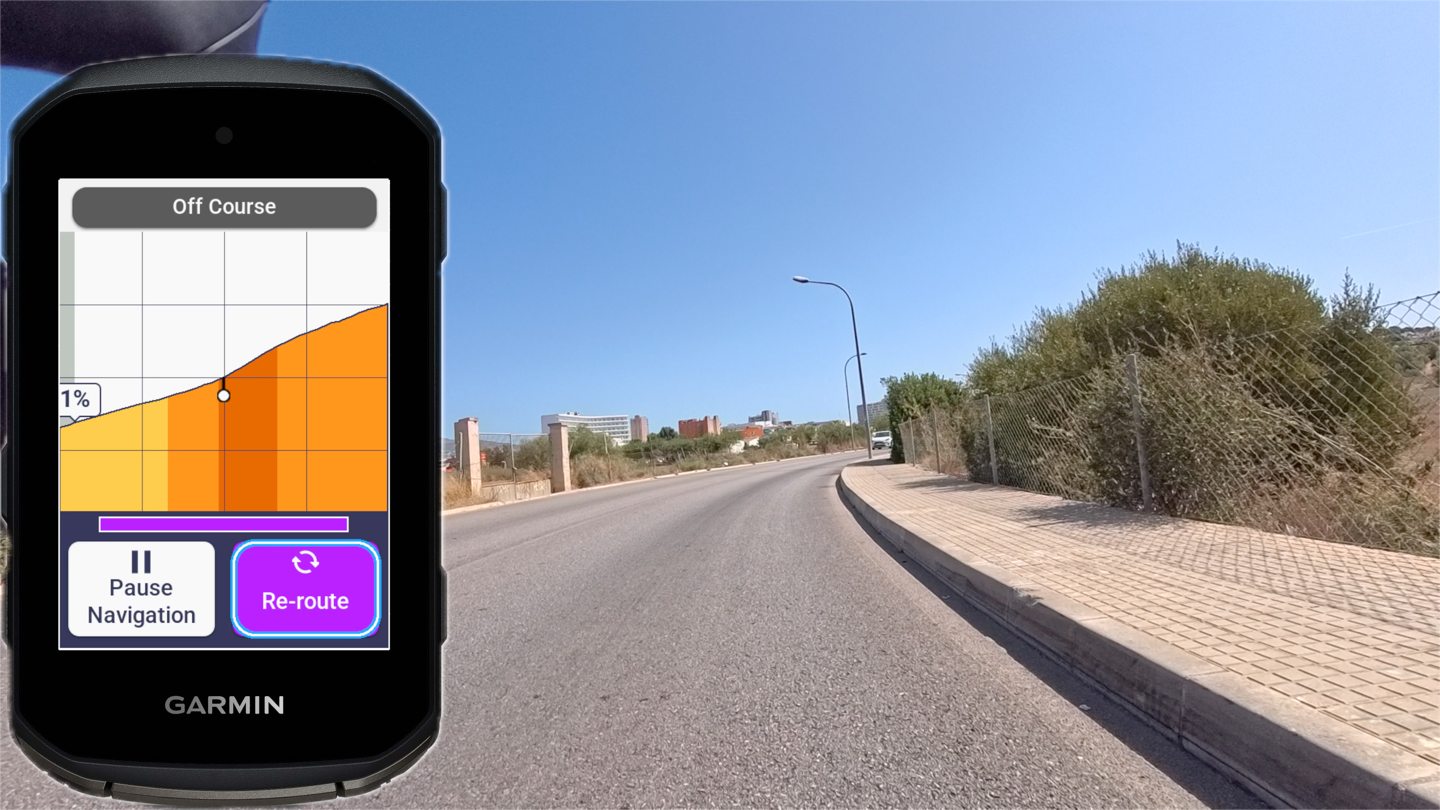
(This screenshot I have is from the Edge 550, I need to regenerate the full-screen recording overlay of the Edge 850 variant of that ride, but it’s nearly identical.)
The automatic recalculation is virtually instant. I suspect it’s simply doing this behind the scenes while it waits for your confirmation, and then boom, it’s ready.
Beyond that, you can always end navigation at any time, as well as navigate anywhere else at any time. The Edge 850 includes a full POI (points of interest) database, as well as the ability to enter actual street addresses. Generally speaking street address entry is pretty cumbersome from such a unit, but hey, it’s there if you want it. You can also do this from Garmin Connect (smartphone app), and send it to the Edge too, which is far more efficient.
Now, whether or not you have navigation, you’ll have ClimbPro, which continues to be one of my favorite features. ClimbPro is supported on both planned routes, and free riding. This means that if you’ve got a planned route, then it can more accurately now the exact course, and thus, the exact climbs you’ll be tackling. Versus with free riding mode, it’ll determine the climbs based on assuming the most logical way up that route (so, if you were to turn off early, then it’d probably assume you’re going to the top of the climb).
You’ll see a note as you approach the start of a climb:
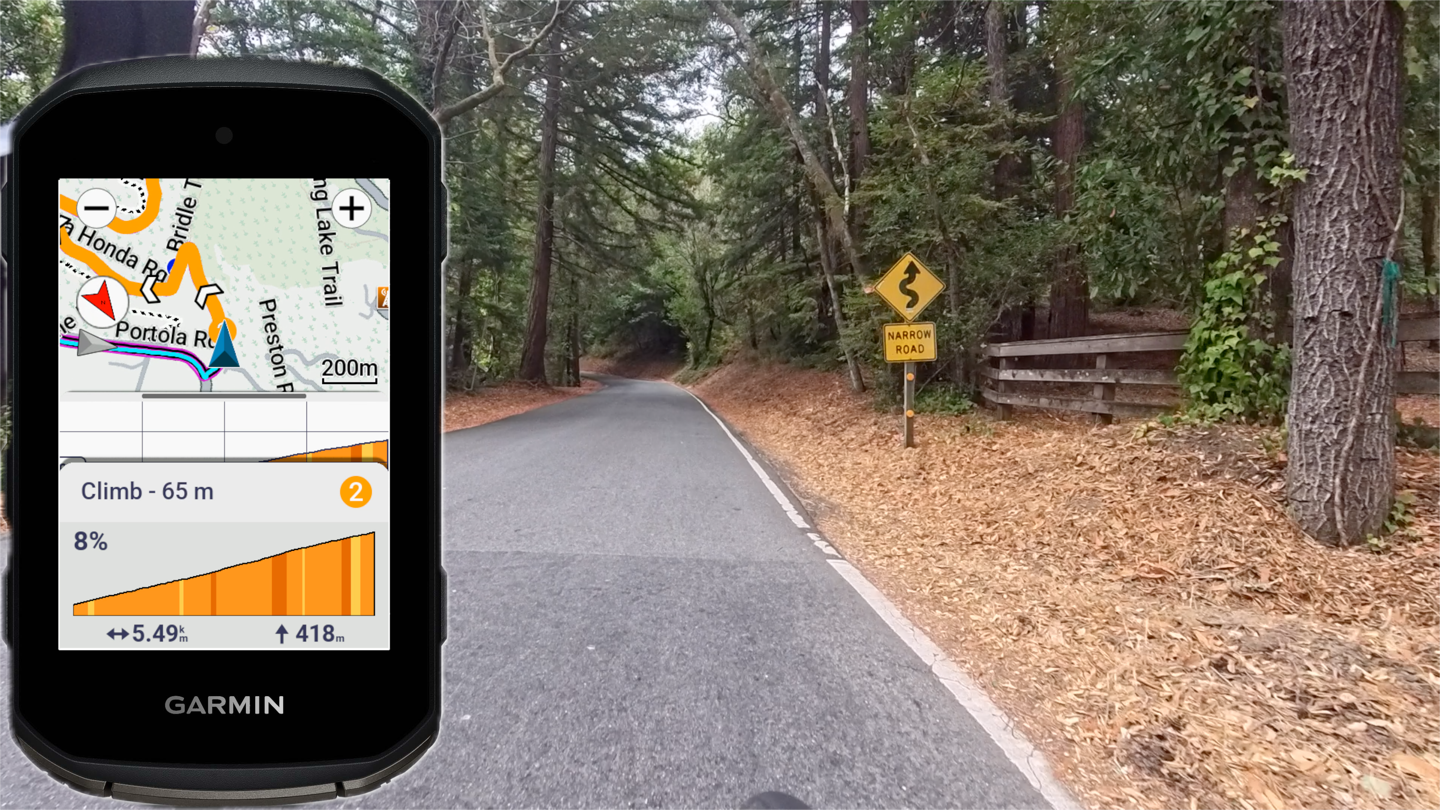
And then details about the climb once you’re on it:

You can change the classification levels that it triggers for, or disable it entirely, if you want. I find it great to know just how much suckery I have left. Though admittedly, there are a few days of long mountain riding where 5-6 hours into it, I just don’t want to know anymore.
Now there are of course, a gazillion features on the Edge series, including structured workouts (downloadable from Garmin Connect, TrainingPeaks, and plenty more providers). As well as Garmin Coach, and automatic workout suggestions. None of these have really changed in terms of the foundational aspects from the past.
One area that was tweaked though is that the Power Guide feature will now account for altitude/elevation. The Power Guide feature is roughly akin to Best Bike Split (except more basic than them), in that it takes a given course, and then, knowing your rider profile, lets you change how aggressively you want to ride the route to give you specific targets:

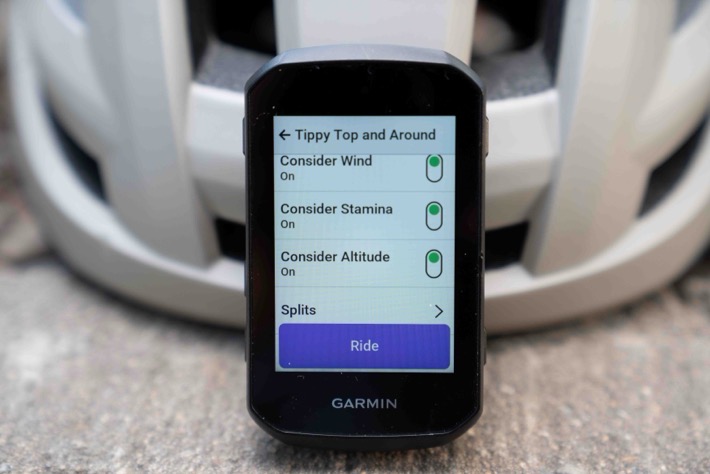
From there, it’ll give you constantly changing targets throughout the ride (which are based on the gradient). So if you have a long flat section, it’ll be the same. Whereas if you’ve got a constantly rolling course, you’ll see it’ll split it up into sections from just a few hundred meters in length, to a few kilometers. You can see these snippets in real-time:
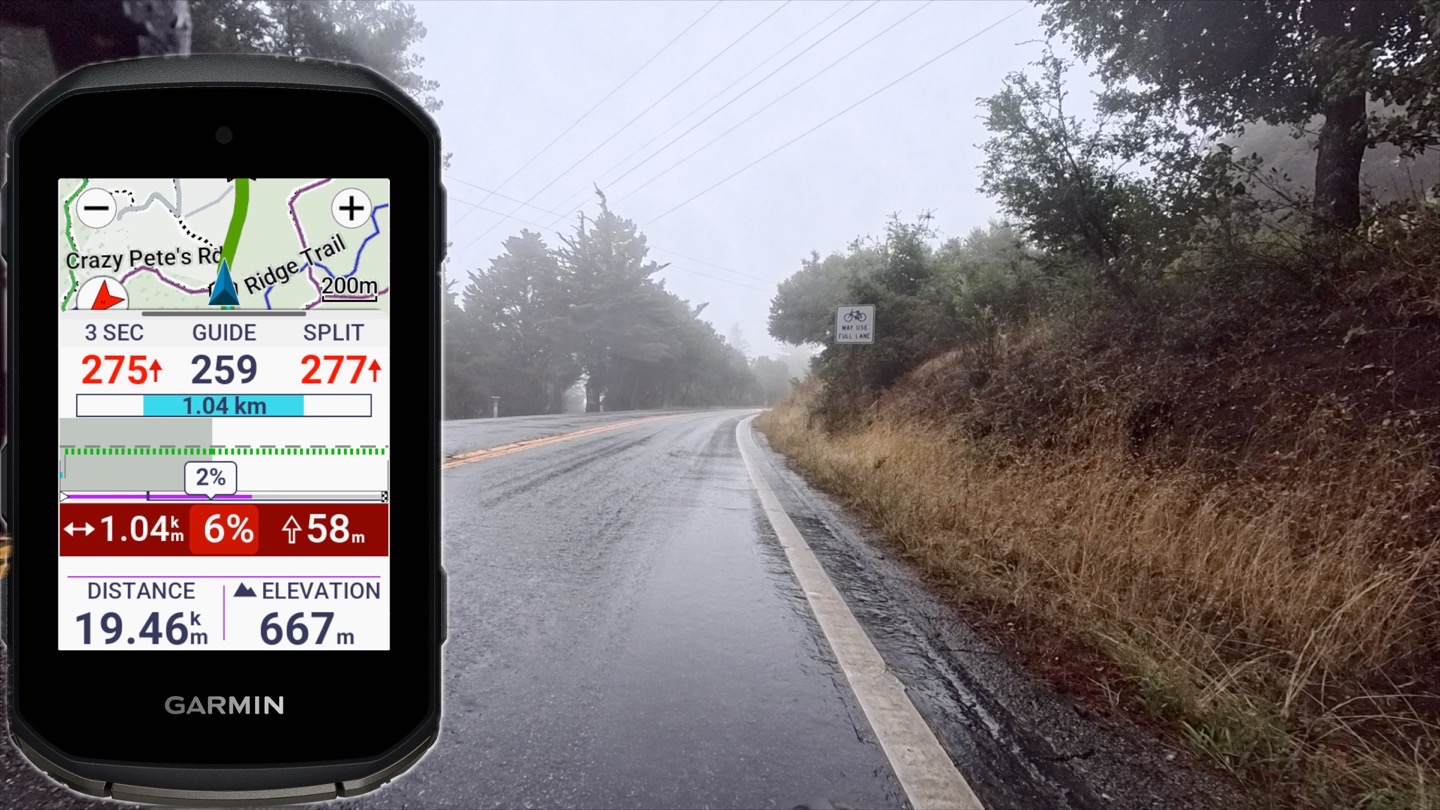
The idea being you can pace a race this way, towards a goal time, with it optimized for your abilities. With the Edge 550/850, it now accounts for the altitude of the route. Meaning, if you’re not acclimated to a high-altitude course, it’ll account for that, so it doesn’t kill you too quickly.
Brilliance or Battery Life:
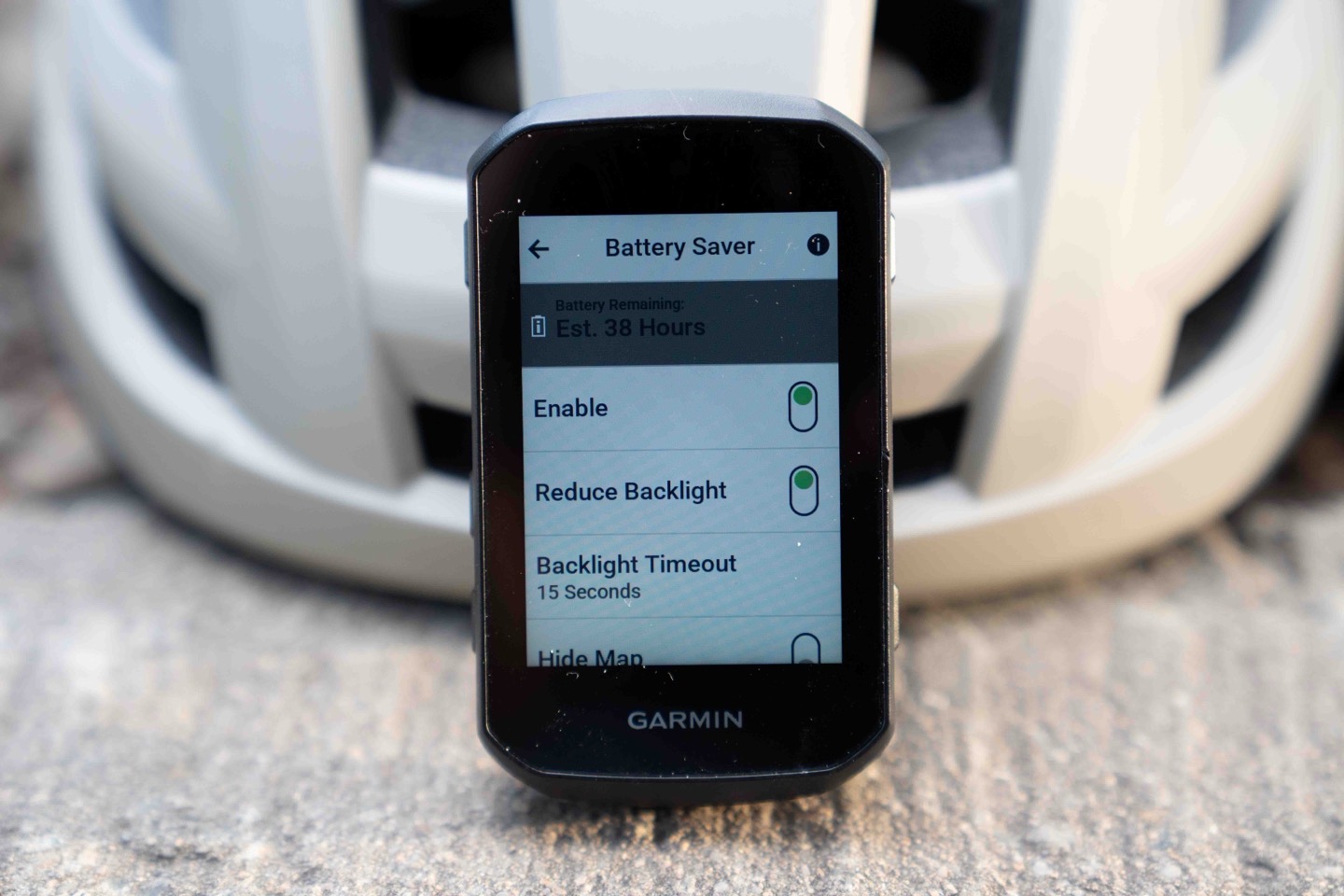
Much like the Edge 1050, you now get a much brighter display, except, at a significant cost of battery. And slightly more problematically, there isn’t a choice anymore. With the Edge 1050, Garmin kept around the Edge 1040 Solar (including all the feature updates), allowing folks to choose ‘battery or brilliance’. Now though, the Edge x40 series is most definitely considered prior generation, and thus will stop receiving major feature updates (it’ll continue to get bug fixes, minor things, etc…).
In this case, the claimed battery life of the Edge 550 and Edge 850 units is a mere 10-12 hours in a standard configuration. What does Garmin define as standard? Well, it includes everything below, including dual-frequency GPS.
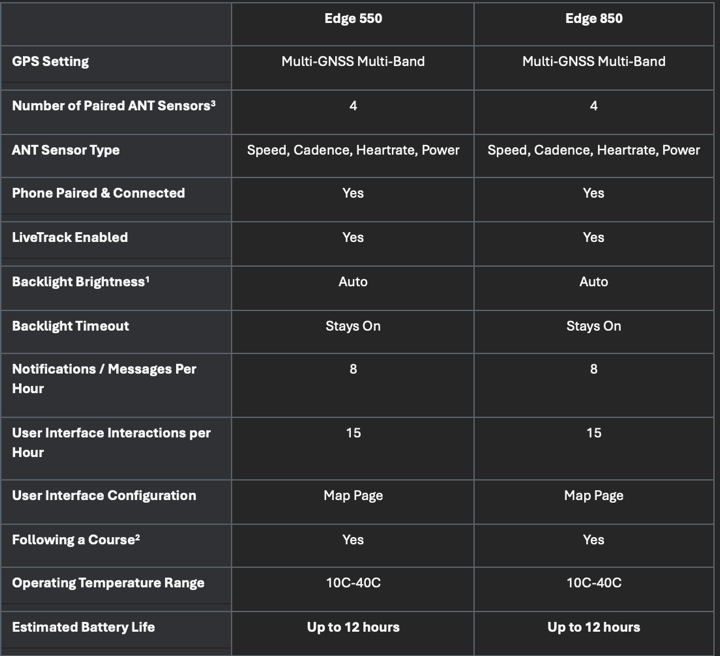
Across all of my rides, this setup has led to being near spot-on the battery claims (for better or worse). For example, here’s a 2.5 hours gravel ride on a warm toasty day, with navigation enabled, and me spending about half the time on some sort of climbing+map or map navigation page:
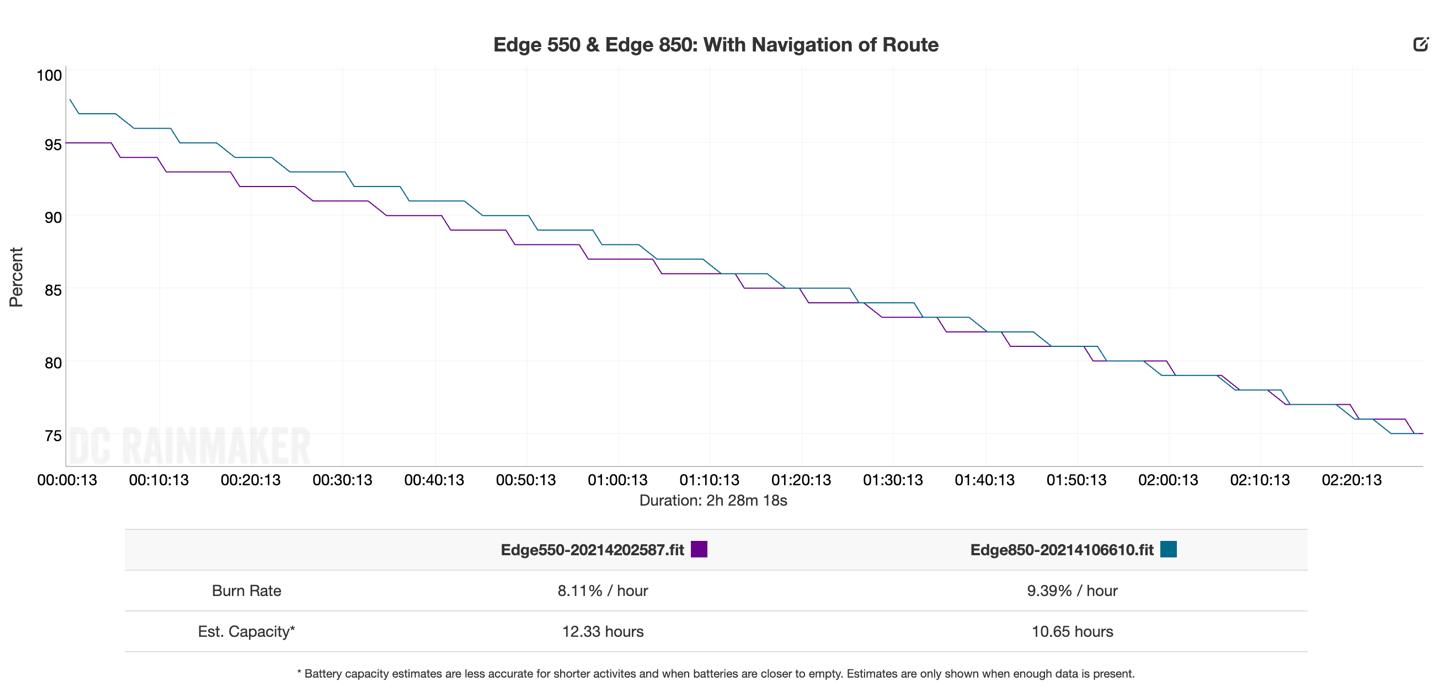
As you can see, estimated battery burn puts me at 10-12 hours on the Edge 550 & Edge 850.
Here’s another ride, this time a road ride along the coast for just short of 90 minutes. In both of these cases it was connected to an ANT+ power meter, ANT+ heart rate sensor, ANT+ SRAM electronic shifting, and my phone for Bluetooth LiveTrack. No navigation was enabled:
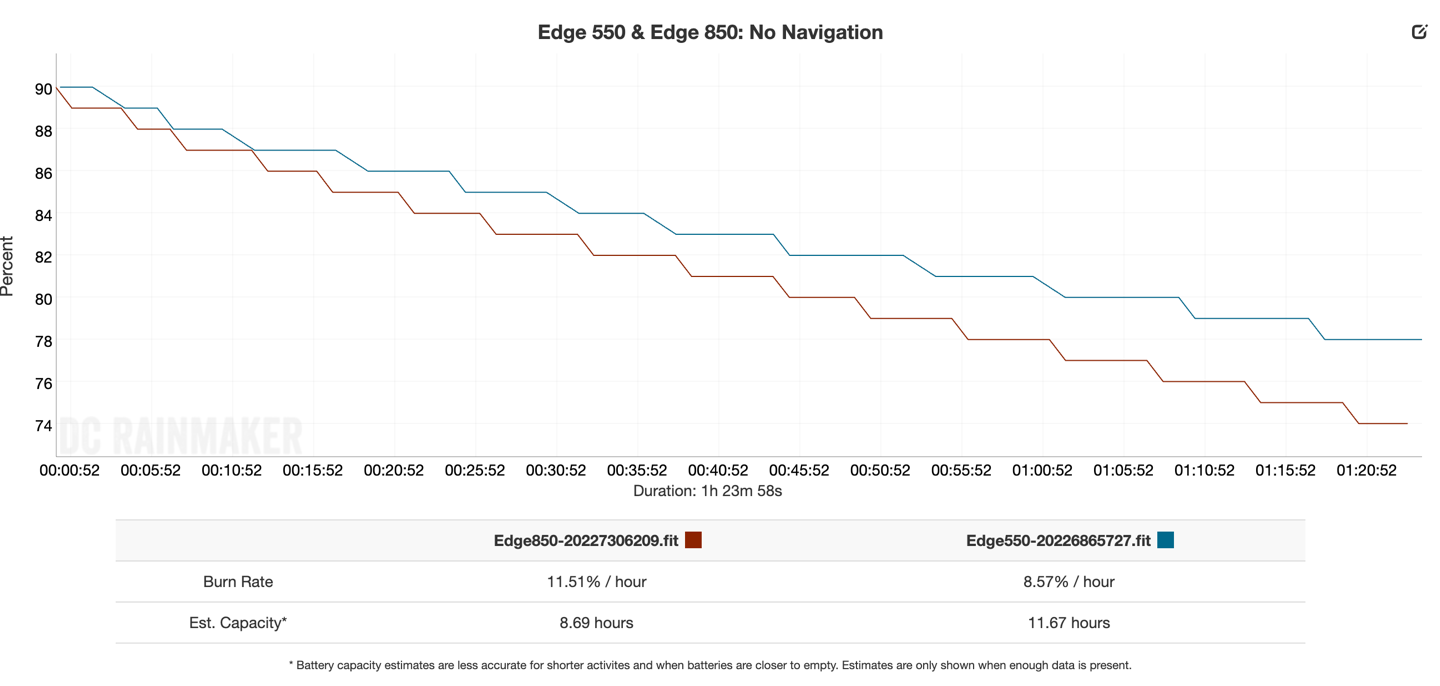
For whatever reason, the Edge 850 was a bit less this time, though the Edge 550 again in the 10-12-hour range. The key thing here is that navigation
Now, for this next one, I tried as darn hard as possible to keep it purely on a data-only screen. The small challenge with that is that when ClimbPro would kick in (for a few climbs lasting about 25-30 minutes in total), it’d shift back to the map+climb screen. But nonetheless, the rest of the time just data only. Here’s that.
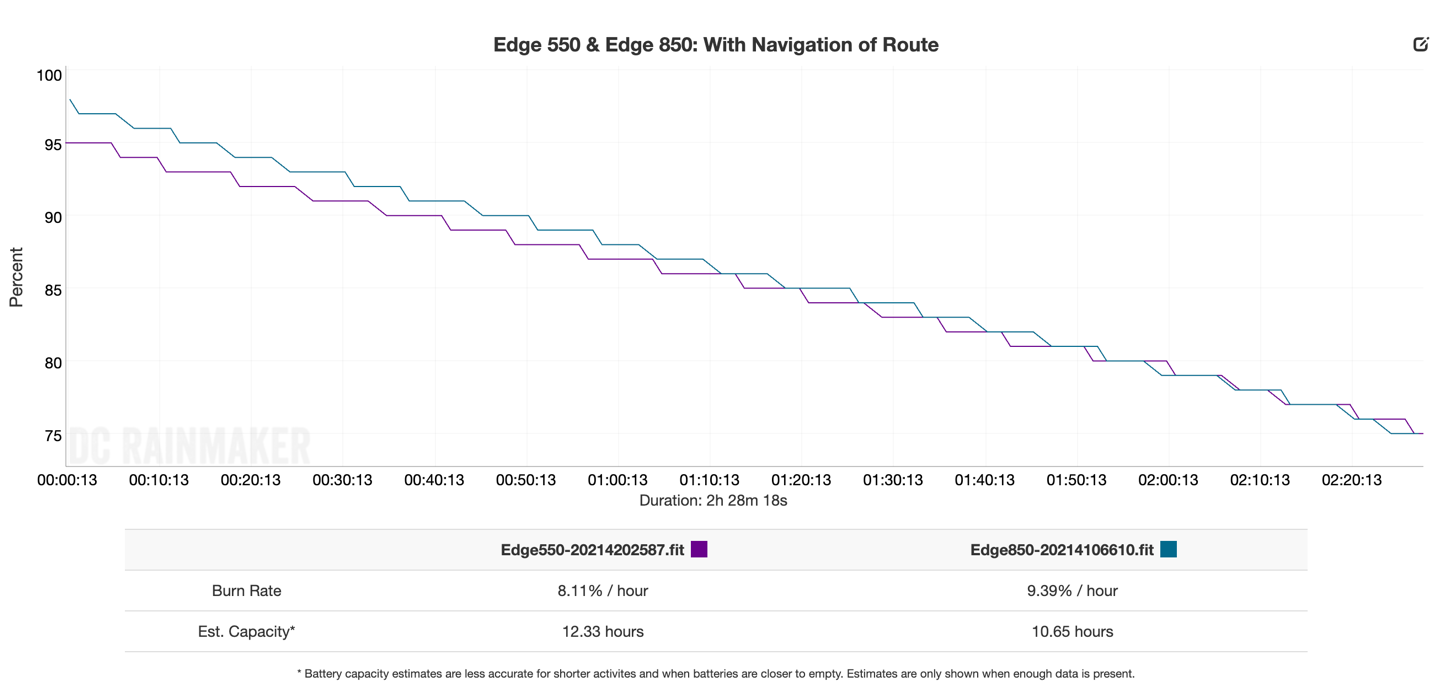
As you can see, that improves things a bit, but we’re still in the same general 10-12hr ballpark.
Next, what if I reduce the GPS setting from dual-frequency/multi-band, down to just All Systems. In most road-cycling cases, you’ll never be able to tell the difference between these two. But, I was curious about the battery life differences:
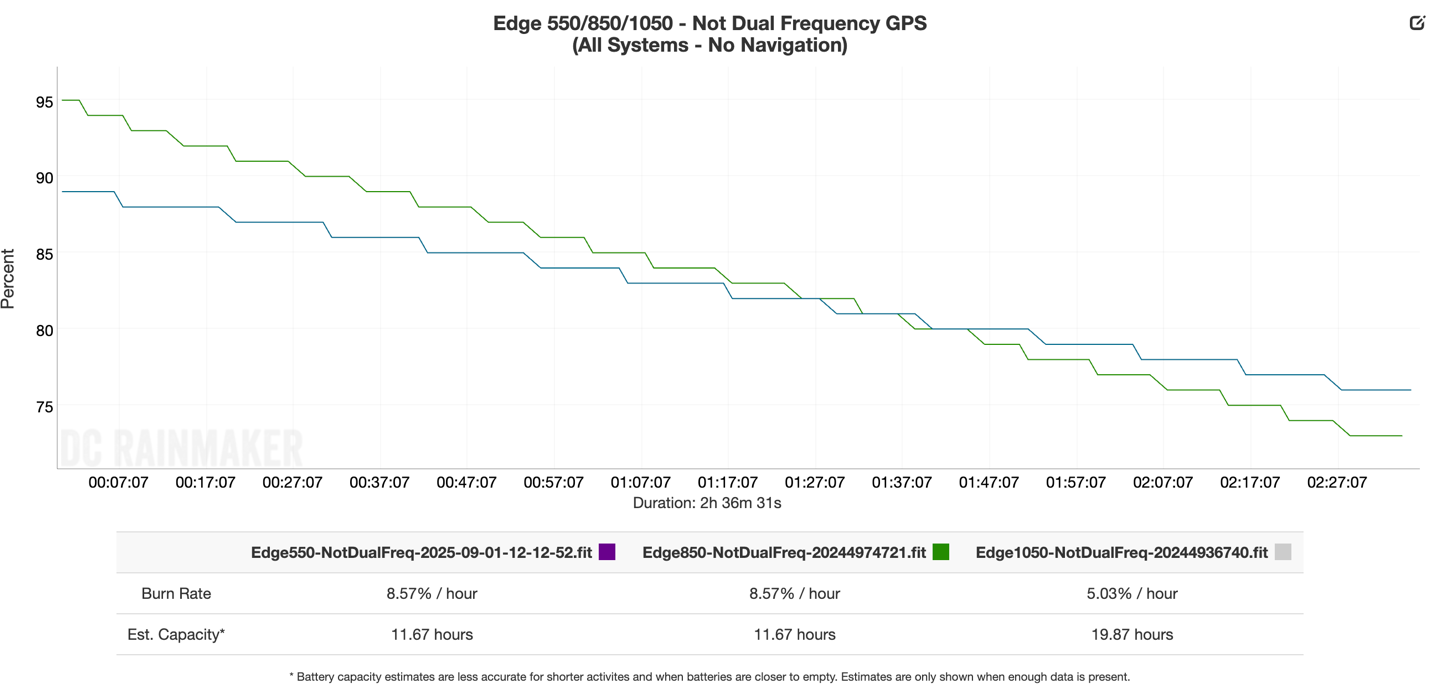
And you can see, that helps a tiny bit, but ultimately, it’s that super-bright display that’s burning the house down.
Finally, what if I changed the brightness from Auto to a set level of 30% brightness? Would I get the battery back? The 30% brightness level is basically the same as Wahoo’s ROAM V3 in a ‘full brightness always on’ configuration. First, here’s the three side-by-side:
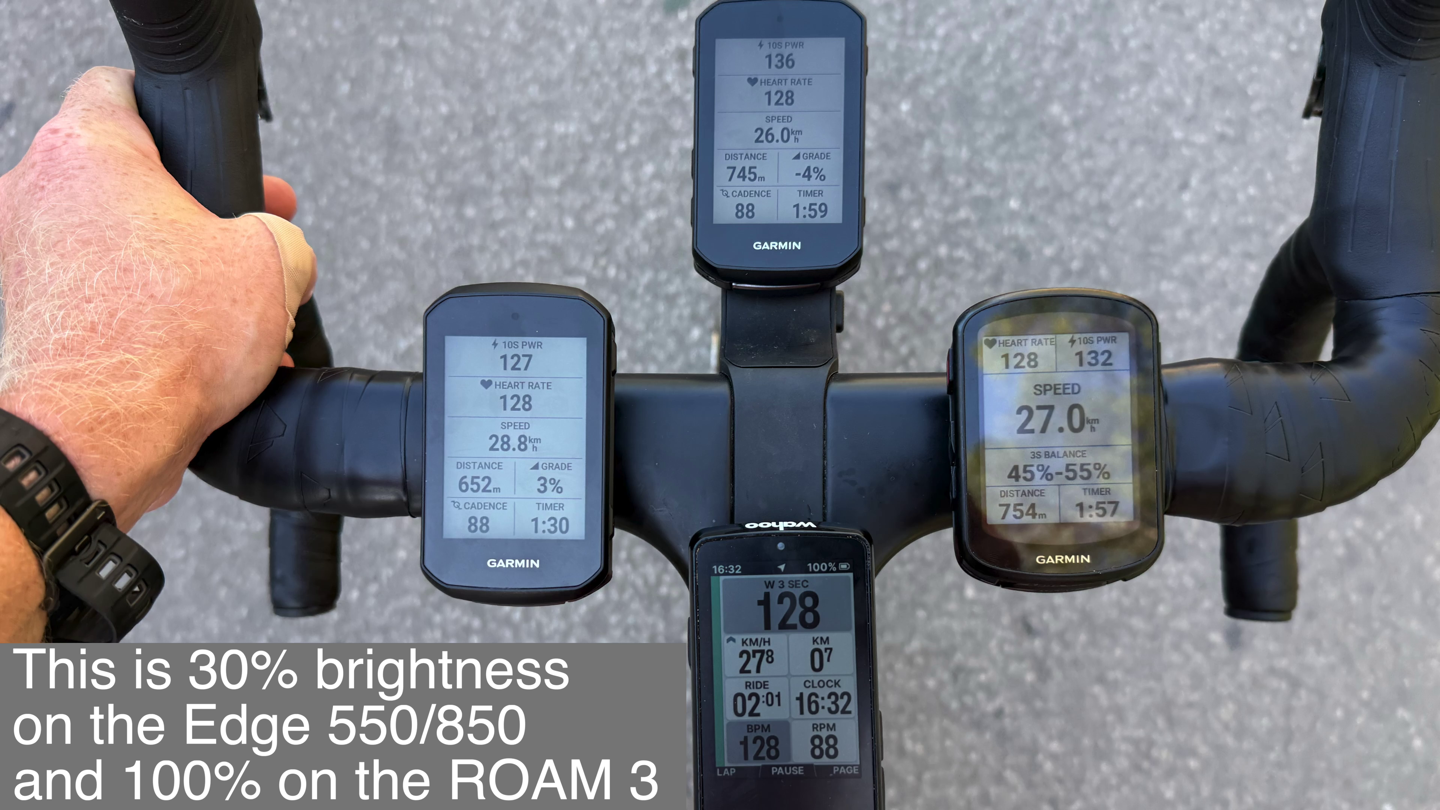
The visibility in this setting is perfectly fine for overcast days (honestly, more than fine) or anything that’s not super bright. But, it does struggle in direct summer sunlight in this configuration. (Side note: In my video I go on an entire tangent about how Wahoo fakes their battery %’s for the first hour of every ride, but I’ll sidebar that for now here.)
In any case, that basically doubled the battery life to 20 hours (the Wahoo ROAM V3 floated at 10%/hour, or 10 hours):
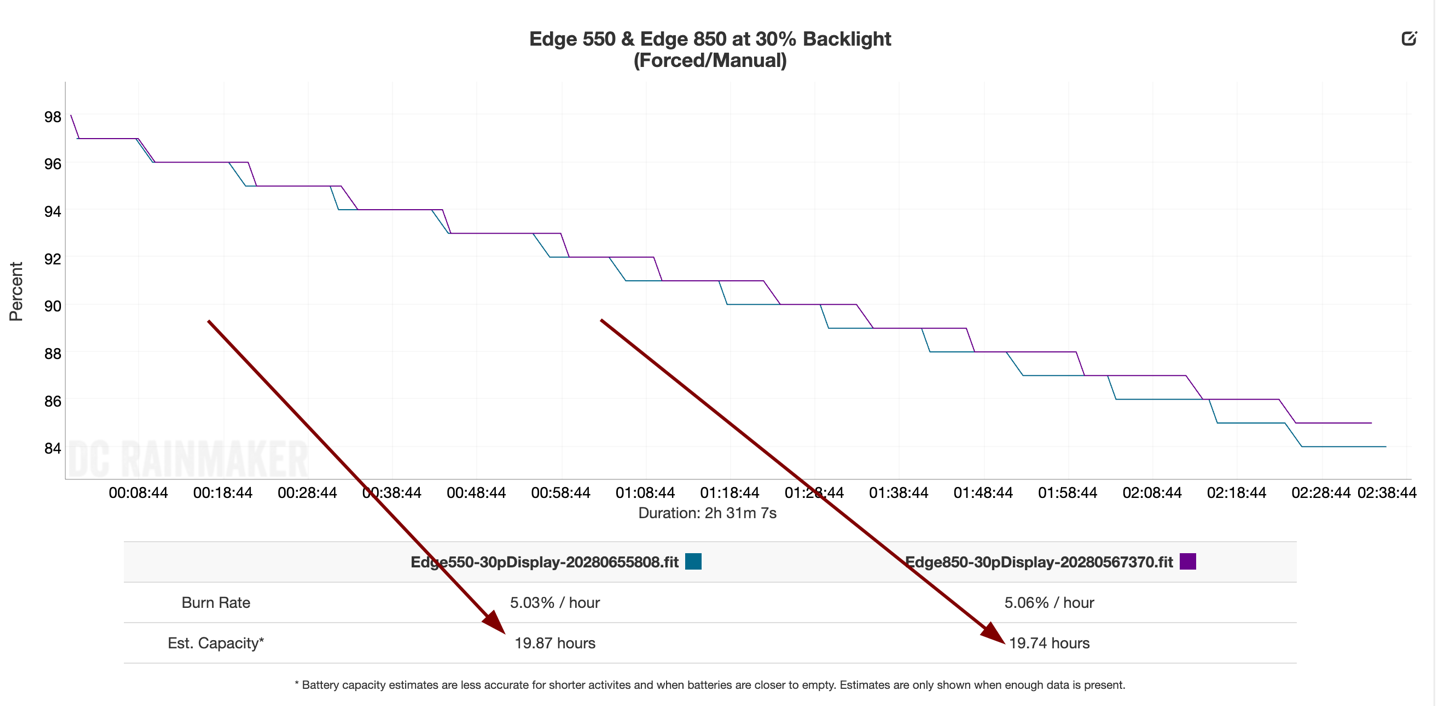
Still, Garmin’s display tech works best in the ‘Auto’ mode, in terms of dealing with bright sunny days. So in this case, it wasn’t a great user experience on said sunny day. On a cloudy day, it’d be great.
Ultimately, Garmin seems to be leaving a massive gap for their competitors to eventually drive through. Or, perhaps they already have with the COROS Dura. Albeit, to be super clear, it has but a fraction of the features of any Wahoo/Garmin/Hammerhead device, but, with substantially better battery life than these new units. Of course, you can always just get an older Garmin unit and still have more features at a bargain price.
GPS & Elevation Accuracy:
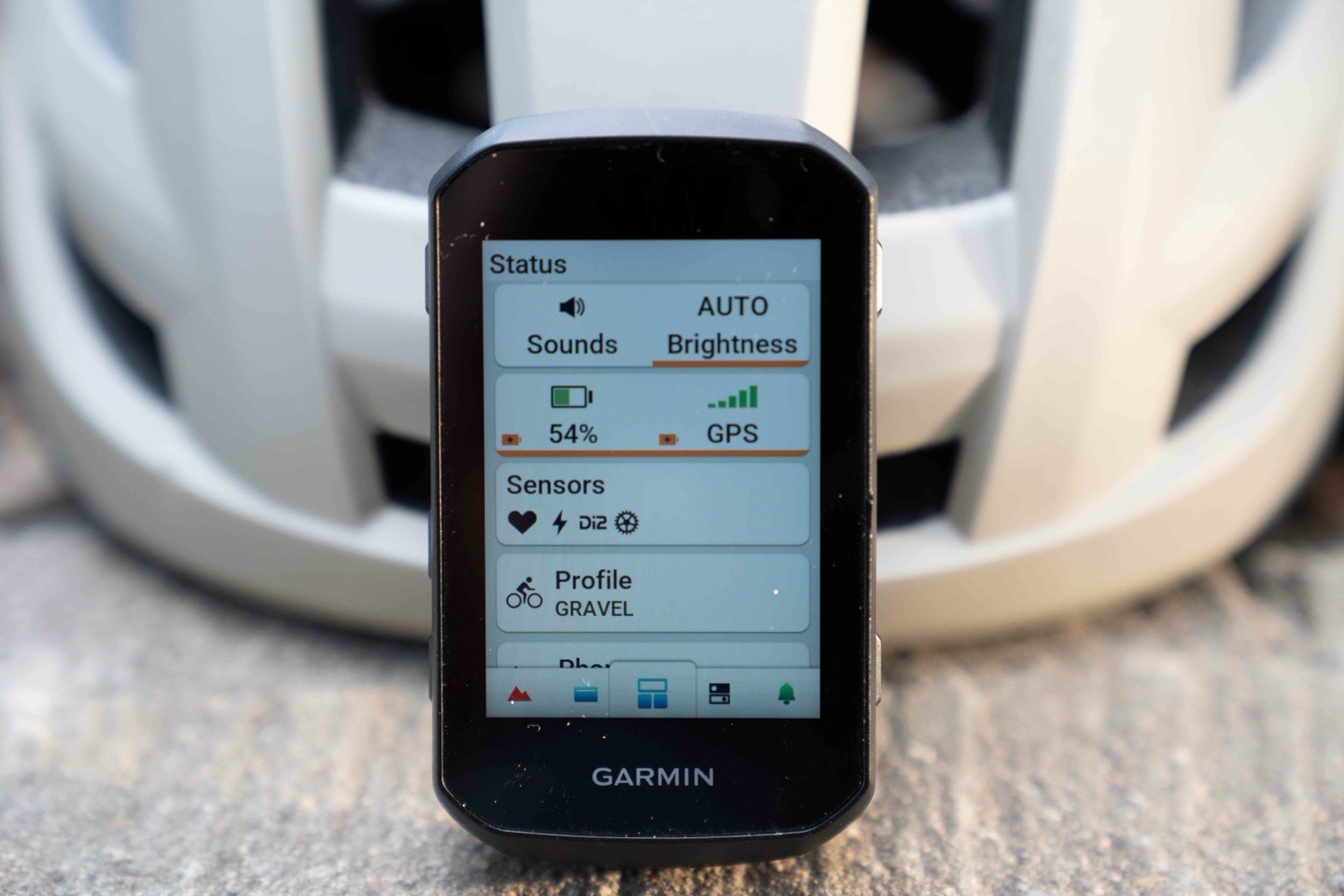
This will not be a complex section, or a long section. Frankly, I can just summarize this entire section with: Everything has been spot-on, even when lowering the GPS accuracy down, it’s still spot-on with its dual-frequency competitors.
Nonetheless, let’s quickly run through some things. We’ll start off with elevation first, just because I never do that first, and it’s 3:13AM and I need some variety in my life. Here’s this morning’s ride, which started in the sun, then climbed up into the clouds/rain/coldish, and then descended back down into the warm sunny valley below.
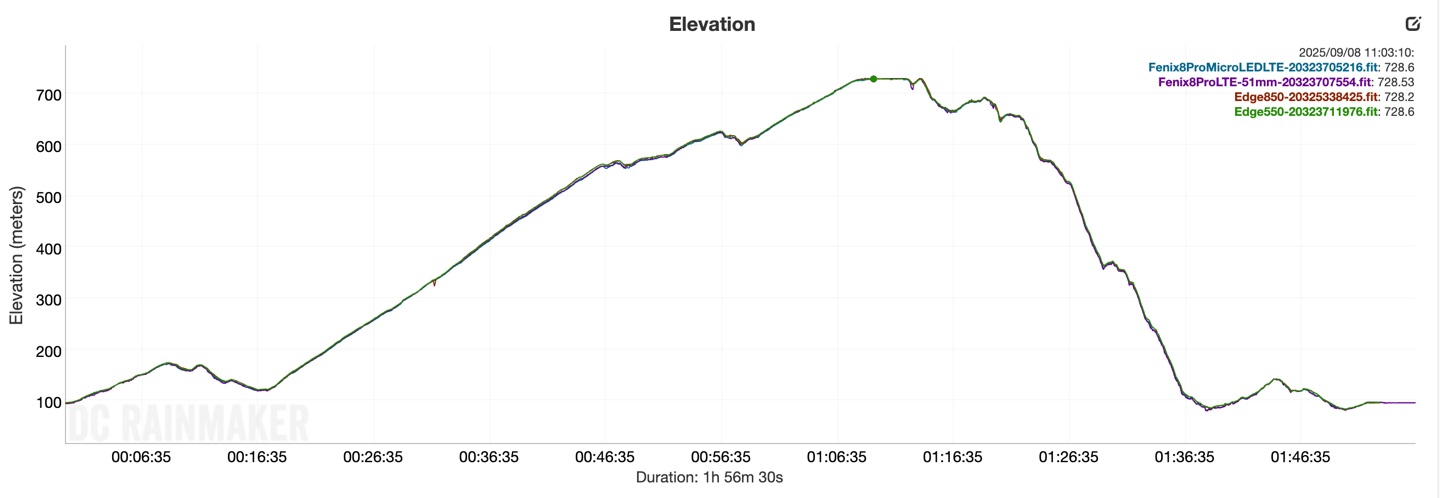
As you can see, everyone was stuck together nice and tight.
Next, another one, this time in the mountains back home, for a 2.5hr ride. As you can see, they were all very close (the other two units were the Wahoo ROAM V3 & Edge 840). While it looks like there was some separation (and there was), it was a mere 5 meters apart (the ROAM varied, rightly or wrongly).
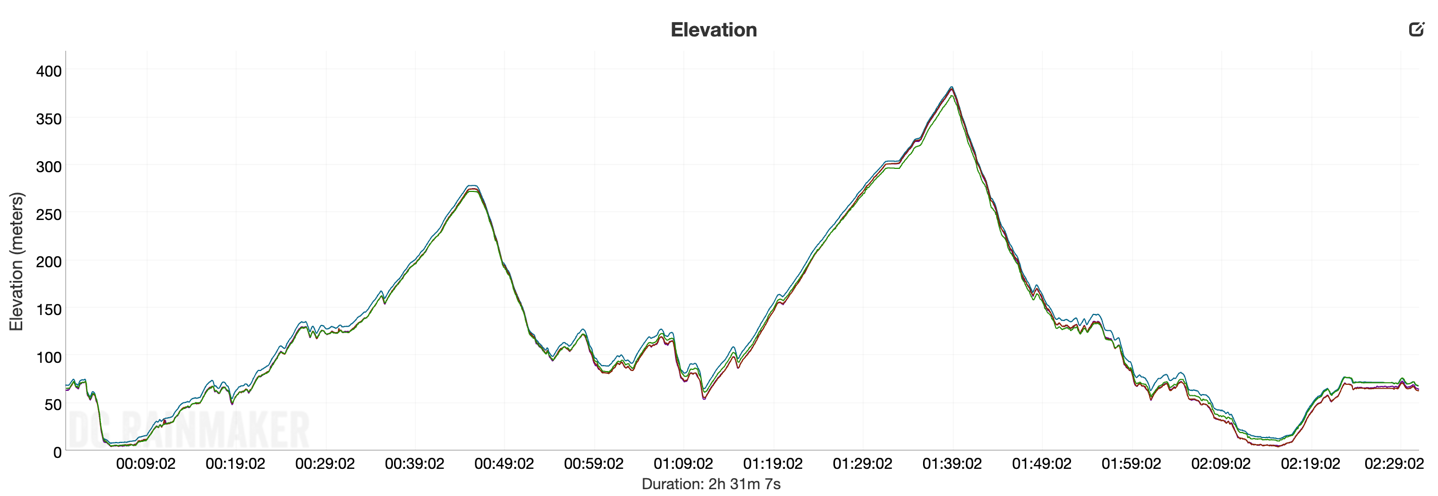
Next, this gravel bike ride – again – everyone literally identical:
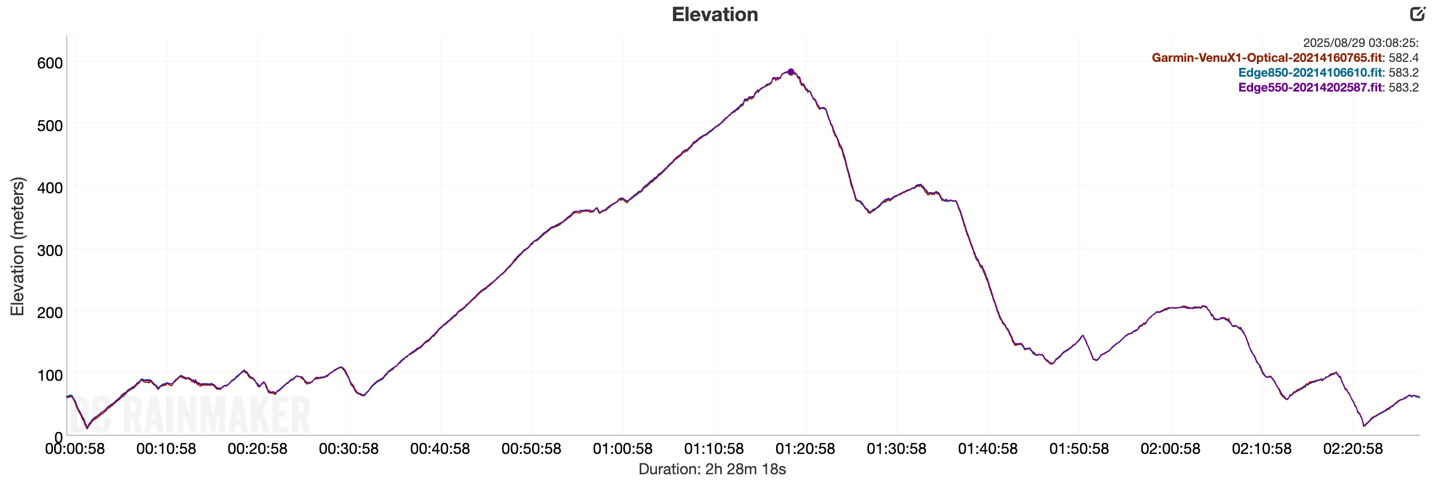
So, let’s look at some GPS track instead. Back to this morning first, up into the redwoods and twisty roads:
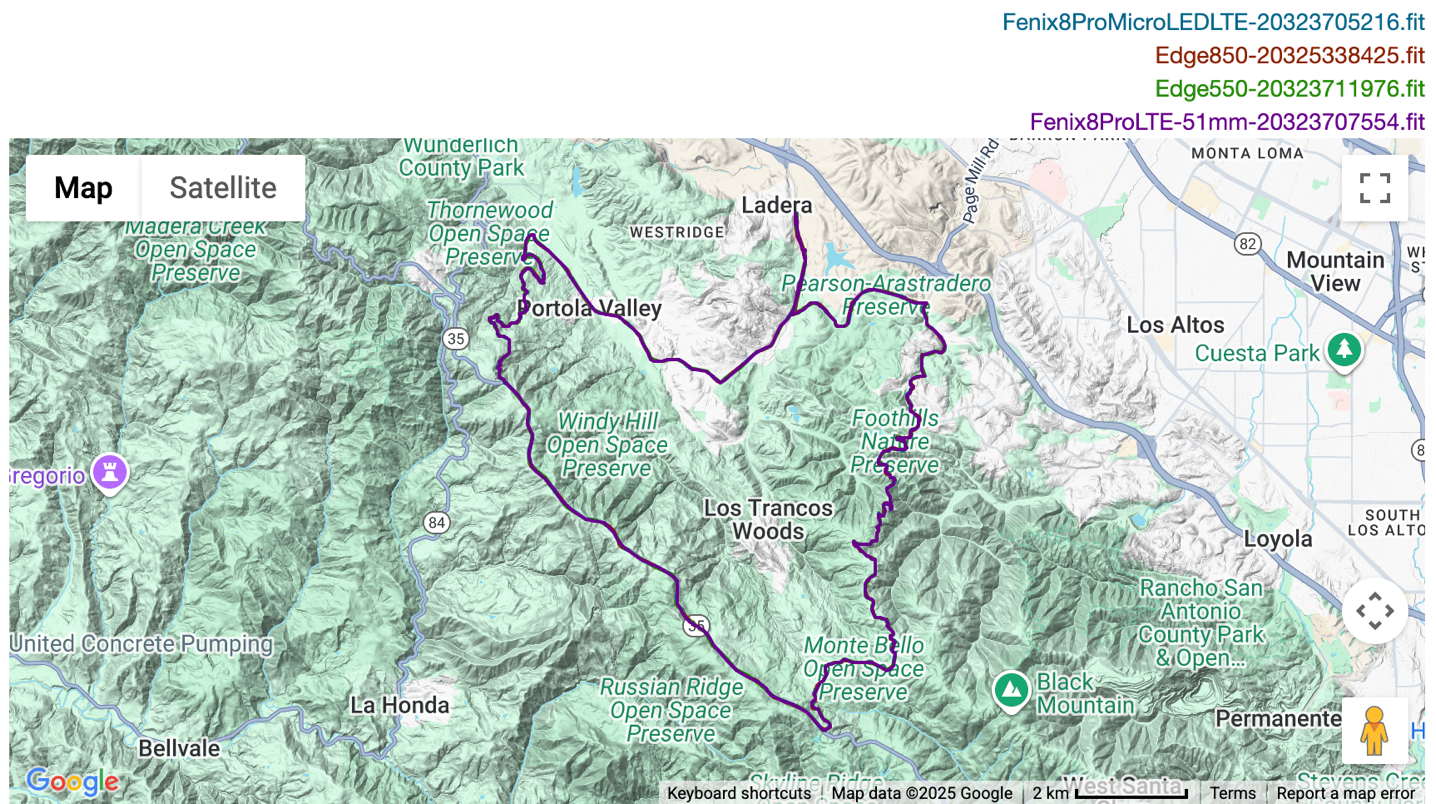
In zooming around, I can’t find anything that’s different than perfectly stuck to the road:
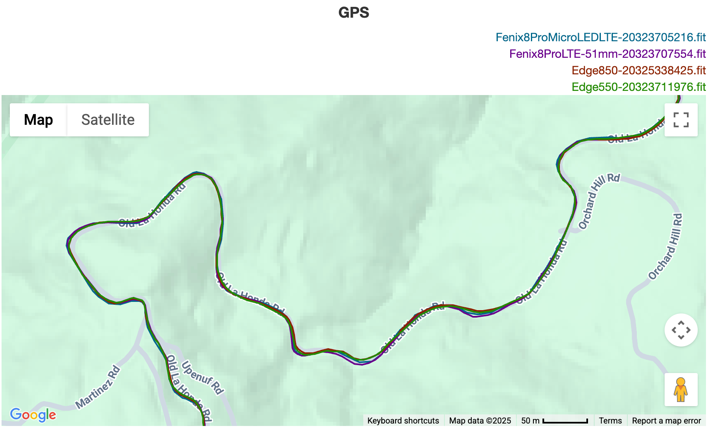
(At left, going up, and at right, going down)
Here we are for some gravel riding in France:
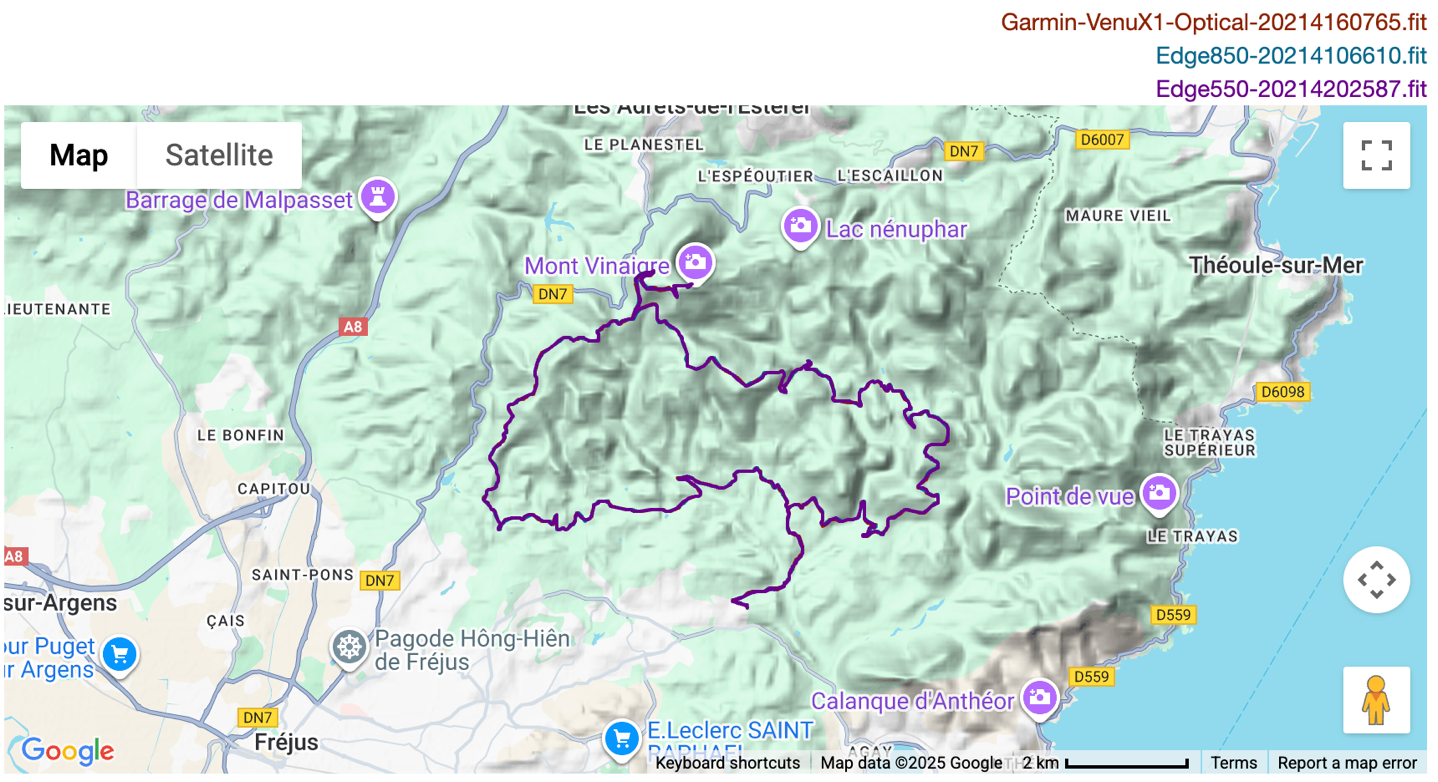
And again, even high speed descents in the trees had no differences:

And then at home:
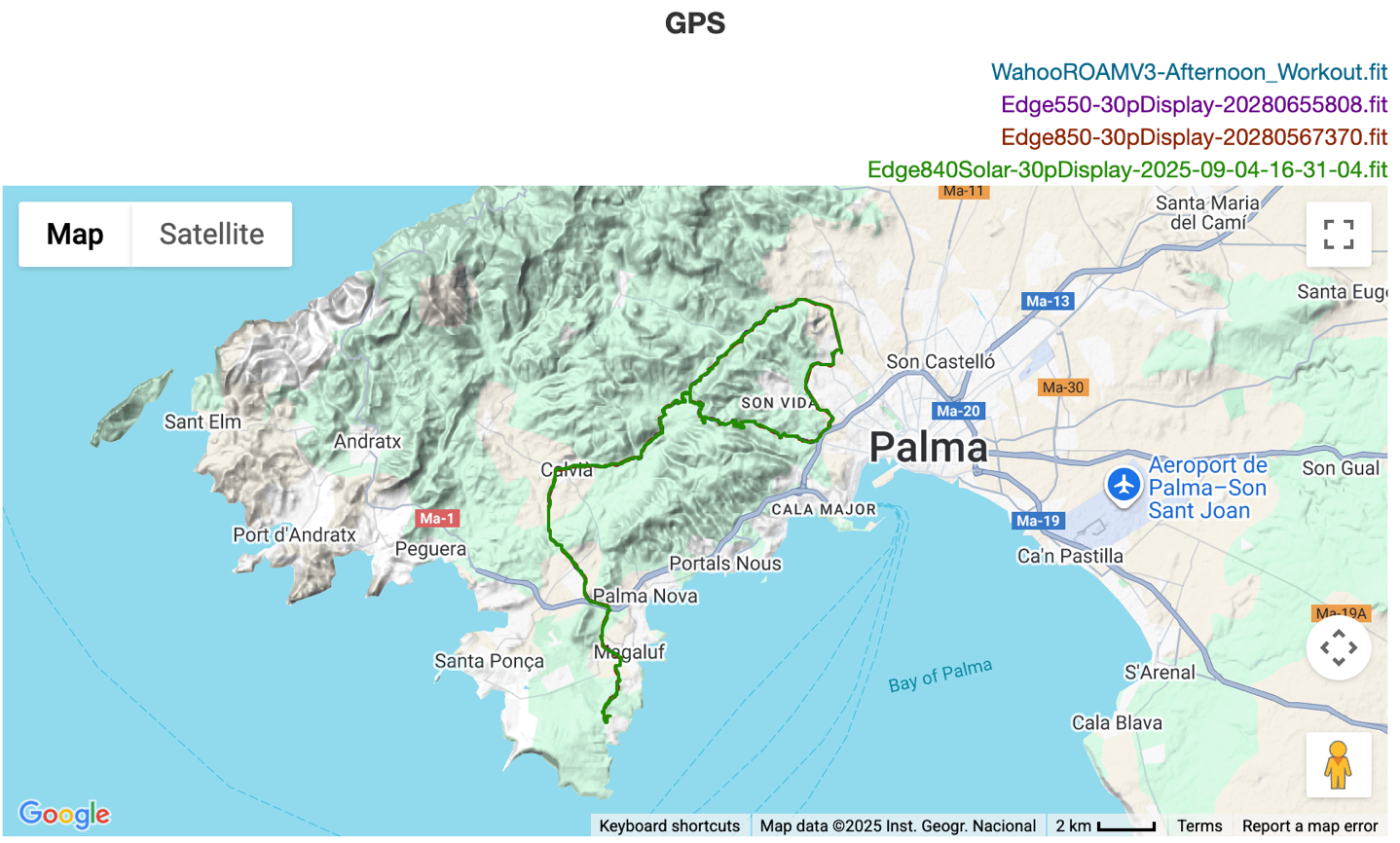
Just no differences up in the mountains on some very fast switchbacks, especially for a section I do often, and thus at a bit higher speed than your average bear:
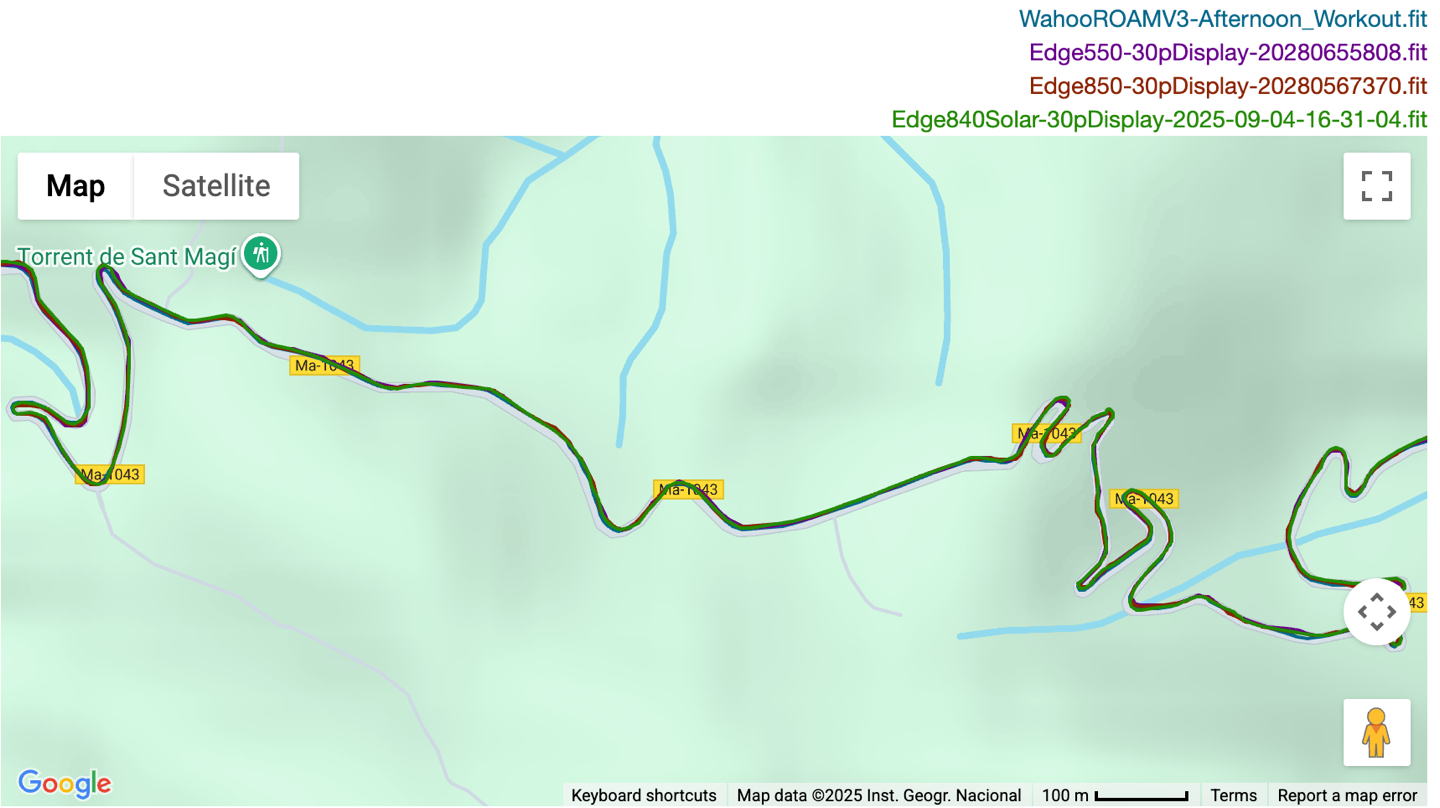
Ultimately, everything I see here from Garmin (and the Wahoo ROAM V3 too for that matter), is spot-on when it comes to GPS & elevation accuracy.
Oh, and for lack of anywhere else to put it, I didn’t see any meaningful/substantial bugs with the Edge 850. I saw one singular bug with a single timing gate placement not triggering, which upon some digging appears to be a more widespread issue with how the UI works for timing gates, and I thought I had set the entry gate but actually not pressing enough buttons. I had two minor bugs on the Edge 550, including one crash of the weather app (the only crash I had), when I tried to pan all the way from California to Europe and zoom in on a storm cell. Along with one funky data field moment on the Edge 550 during a MTB Downhill automatic lap banner. But otherwise, the units have been fine, aside from issues raised up above in the review (e.g. fueling/nutrition).
Wrap-Up:
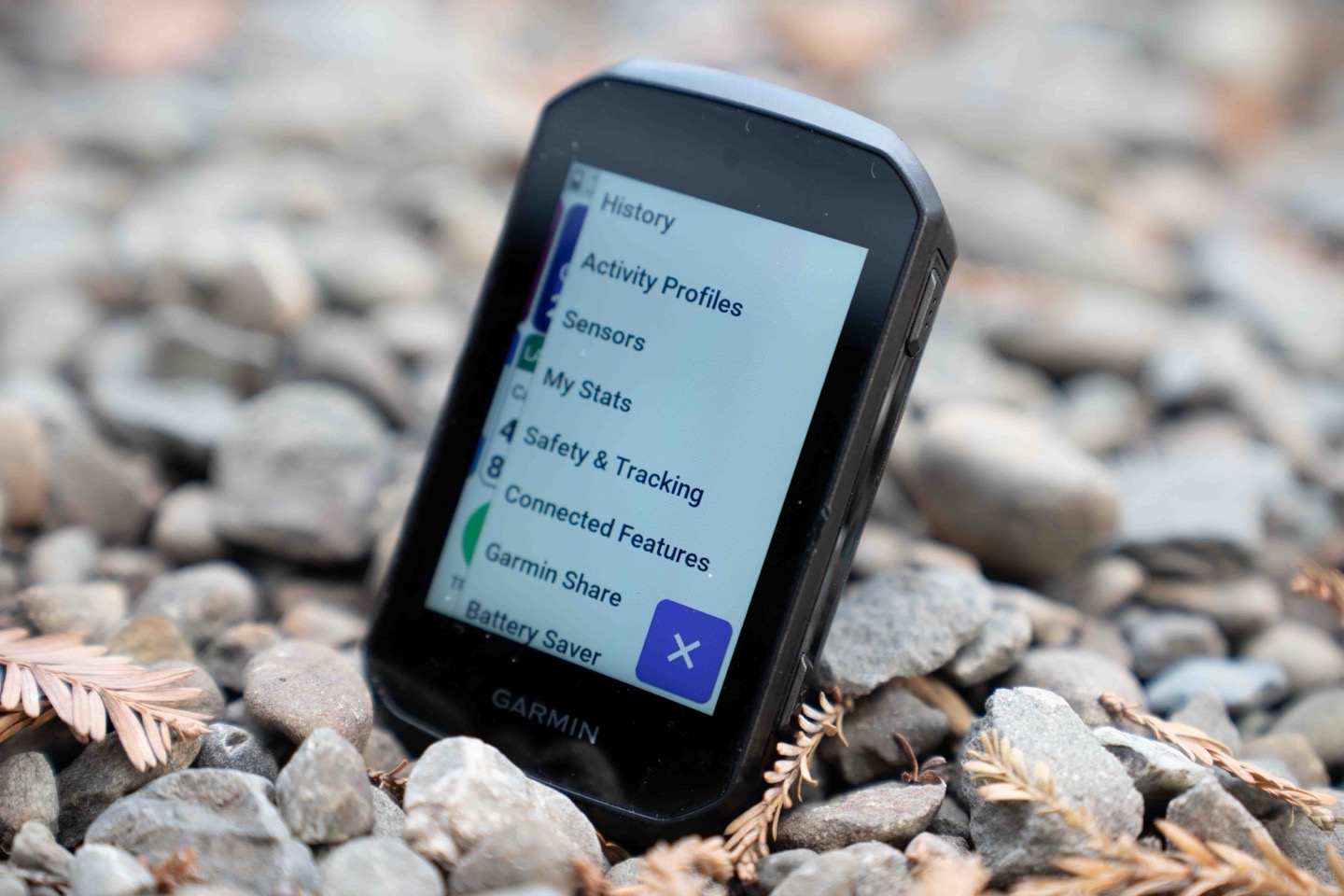
In many ways, you have to look at the Edge 850 through one of two lenses. The first lens is of someone who doesn’t really care about having more than 10 hours of GPS battery life. After all, if they have a radar, they’d be charging that at about the same rate anyway. And 10 hours covers the overwhelming vast majority of cyclists from a weekly totals standpoint. For these people, the brighter and more brilliant display, along with other new hardware features (such as the voice prompts and bike bell), will be welcome additions. After all, I hear virtually no widespread complaints about the Edge 1050, and this is simply a smaller Edge 1050 (with a smaller battery).
On the flip side, in the matter of just a few years we’ve gone from Garmin’s flagship Edge 1040 Solar reaching battery durations close to 100 hours (or more), and the Edge 840 solar easily getting 40-50 hours in the right configuration. Now, we’re at but a fraction of that. Now, as I said in my video, at least with this display tradeoff, you can actually see the darn display – something that Wahoo hasn’t accomplished with the new ACE/ROAM3/BOLT3 displays. Those really struggle in lower light scenarios, without fully cranking up the backlight. Whereas Garmin’s automatic backlight option here works super well, and when used (it’s enabled by default), you just don’t think about it – it simply works.
Of course, there is the whole pricing increase. Part of that is unquestionably tariff-related, but part of it is also driven by the prices that Wahoo & Hammerhead set (Wahoo Roam 3 at $464, and Hammerhead Karoo 3 @ $525). In doing so, I can absolutely see how Garmin got to their $599 valuation. Simply put, is the Edge 850 worth $75 more than the Karoo 3? Of course it is. Next, is the Karoo 3 worth $60 more than the Wahoo ROAM 3. Yes, very easily. And thus, here we are. I’m not thrilled with it either, but Garmin has always been the premium-priced company, and when its competitors inflate their prices, Garmin is simply going to respond accordingly. They know they have a substantially better product, and they aren’t afraid to price it as such.
Which is an interesting contrast in pricing to the just released Garmin Rally 110/210 power meter pedals, which, despite being very good, simply doesn’t have a substantially different/better value prop than the also very good Favero RS series, yet, cost nearly twice as much. In that case, it’s an easy choice. But, let’s save that for the other post.
With that, thanks for reading!

0 Commentaires